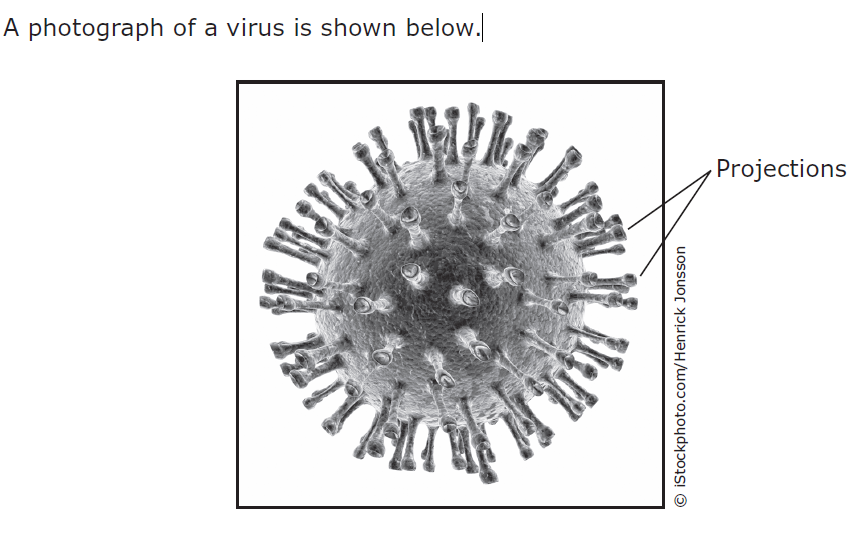
The projections on the surface of this virus allow the virus to
—
A move inside a host cell
B attach to a host cell
C
control a host cell’s DNA
D signal other viruses to infect a host cell
b

Surtsey is an island located south of Iceland. The island was formed by a volcanic eruption and first appeared in 1963. The table below contains descriptions of changes in the population and diversity of species on Surtsey
Which of these lists the descriptions in the correct order of
ecological succession on Surtsey?
F I, II, IV, III
G III, I, II, IV
H IV, III, I, II
J II, IV, I, III
j
Having a standard taxonomic system benefits the scientific community
by allowing scientists from all over the world to do which of the
following?
A Have a common system for the classification of
locations containing fossils
B Use a similar system to classify
the impact of removing species from ecosystems
C Have a common
understanding in the classification of organisms
D Understand how
other scientists classify predator–prey relationships
c
The technique known as chromosome painting is the result of
scientific research. Scientists use chromosome painting to mark the
locations of genes on human chromosomes with fluorescent tags. It is
also possible to apply this technique to the chromosomes of many
different species. Chromosome painting allows for which of the
following?
F A comparison of the genomes of different
species
G The sequencing of proteins from many species
H An
increase in mutations in many species
J The extraction of amino
acids from different species
f
Health-care workers are exposed to many different types of pathogenic
and nonpathogenic
microorganisms. Which body systems work
together to protect the body from pathogens?
A Muscular and
vascular
B Digestive and excretory
C Circulatory and
immune
D Endocrine and reproductive
c
Which of these statements best explains the process of energy
conversion that takes place in the mitochondria?
F Energy is
required for carbon dioxide molecules to form six-carbon sugar
molecules.
G Water molecules and radiant energy are necessary for
anaerobic respiration to take place.
H Oxygen molecules release
energy in the form of heat during combustion reactions.
J The
energy in the bonds of glucose molecules is transferred to the
phosphate bonds in ATP.
j
Some organisms have genes that improve their ability to survive and
reproduce. If the genes also help their offspring survive and
reproduce, then which of the following will most likely
increase?
F The frequency of the genes in one individual
G
The frequency of the genes in the population
H The number of
genes in one chromosome
J The number of genes in the species
g
The overgrowth of algae poses a major problem for coral reefs.
Intensive fishing is one factor that contributes to algae overgrowth
because it does which of the following?
A Allows more sunlight to
be available to algae
B Inhibits the spread of pathogens in algae
colonies
C Reduces the number of organisms that feed on
algae
D Increases the competition between different algae species
c
Enzymes are proteins that help increase the rate of chemical
reactions inside cells. These proteins are composed of many simpler
molecules called amino acids. Which of the following suggests that the
shape of an enzyme determines the enzyme’s function?
F Enzymes
are specific to a substrate.
G Enzymes can operate in a wide
range of conditions.
H Enzymes are activated by neighboring
molecules.
J Enzymes can be found in all life-forms.
f
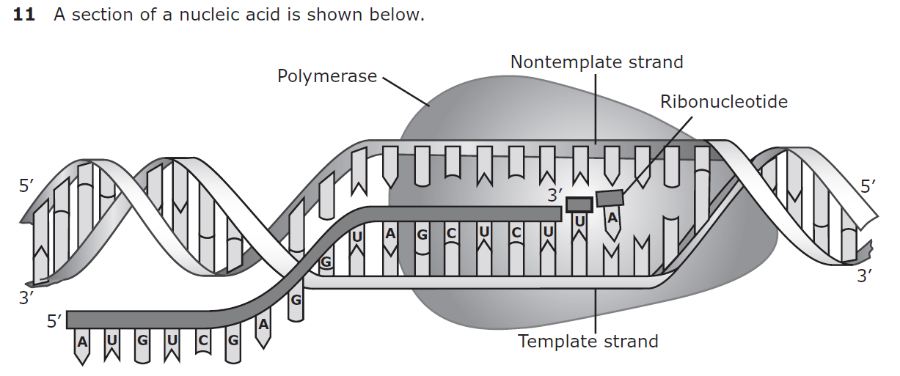
The process represented in the diagram produces a molecule that is
complementary to the template strand of DNA. What type of molecule is
produced?
A New DNA
B Polypeptide
C Messenger
RNA
D Carbohydrate
c
Which of the following correctly describes how a diagram of cellular
respiration would differ
from a diagram of photosynthesis?
F
The cellular-respiration diagram would show electromagnetic waves as
the final
product.
G The cellular-respiration diagram would
show glucose as the main source of energy.
H The
cellular-respiration diagram would show energy stored in large protein
molecules.
J The cellular-respiration diagram would show water as
the main source of chemical
energy.
g
13 If several pea plants with the genotype TTYy are crossed with pea
plants with the genotype Ttyy, what percentage of the offspring will
be expected to have the TTYy allele combination?
A 25%
B
40%
C 50%
D 75%
a
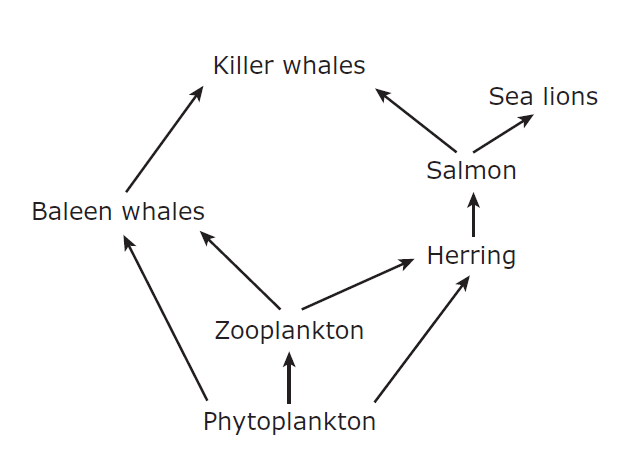
Which of the following are missing from the food web shown
above?
F Producers
G Decomposers
H Omnivores
J Predators
g
The concept of gene flow is demonstrated when a cow is driven off
from its herd, joins another herd, and reproduces. When the cow
contributes to the gene pool of the new herd, which of these most
likely increases?
A Natural selection
B Genetic
variation
C Environmental fitness
D Reproductive mutations
b
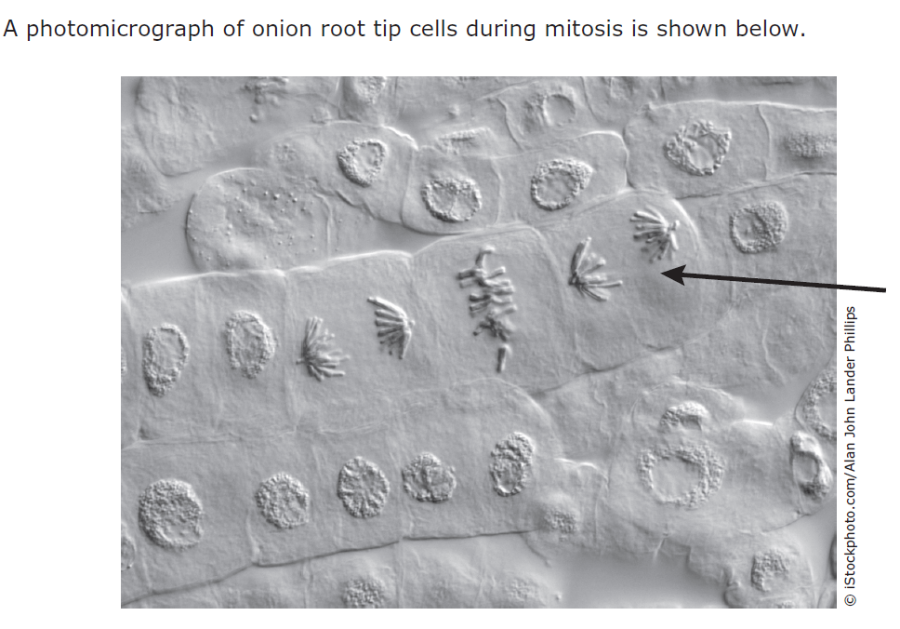
Which phase of mitosis is occurring in the cell indicated by the
arrow?
F Prophase
G Metaphase
H Anaphase
J Telophase
h
A dog’s pituitary gland produces the hormone ACTH, which stimulates
the adrenal glands to secrete cortisol. Cortisol helps regulate body
weight, mineral balance, the structure of connective tissue, the
production of white blood cells, and skin health. When cortisol levels
are low, the pituitary gland secretes ACTH. When cortisol levels are
high, the pituitary gland stops secreting ACTH. Based on this
information, which of the following would most likely be the cause of
elevated levels of cortisol in a dog?
A Undersized adrenal
glands
B An excess of ACTH
C An inactive pituitary
gland
D An immune response to the excess level of cortisol
b
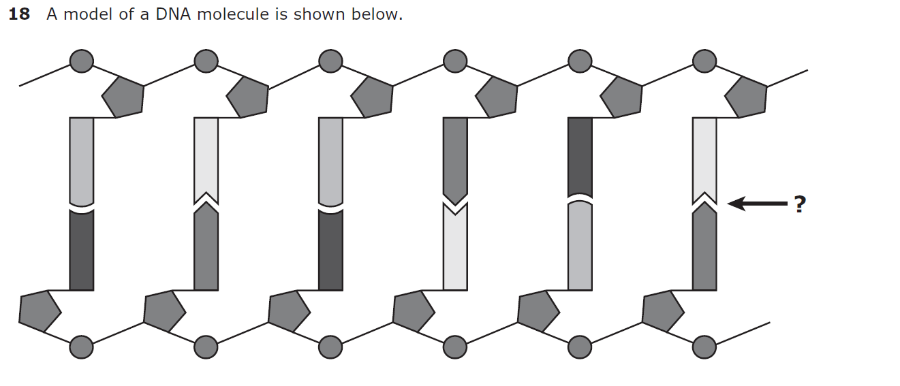
The arrow indicates —
F the bond between adjacent phosphate and
deoxyribose molecules
G the junction of introns and exons in the
sense strand of DNA
H the hydrogen bond between complementary
nucleotides
J the junction of a codon and a DNA triplet
h
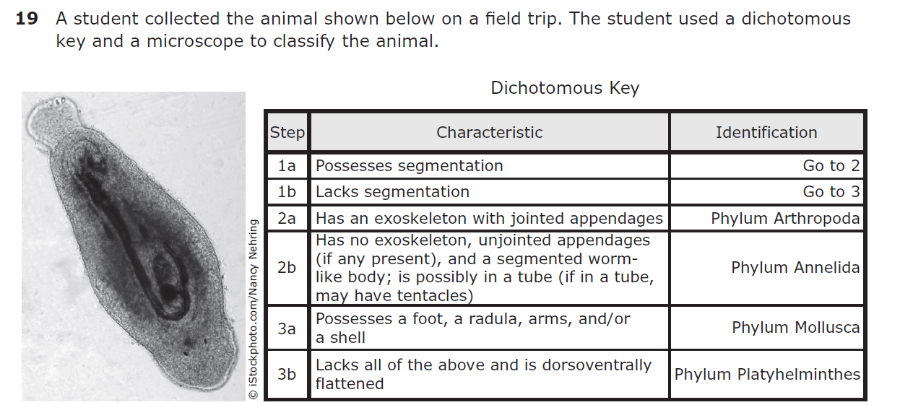
How should this animal be classified?
A Arthropoda
B
Annelida
C Mollusca
D Platyhelminthes
d
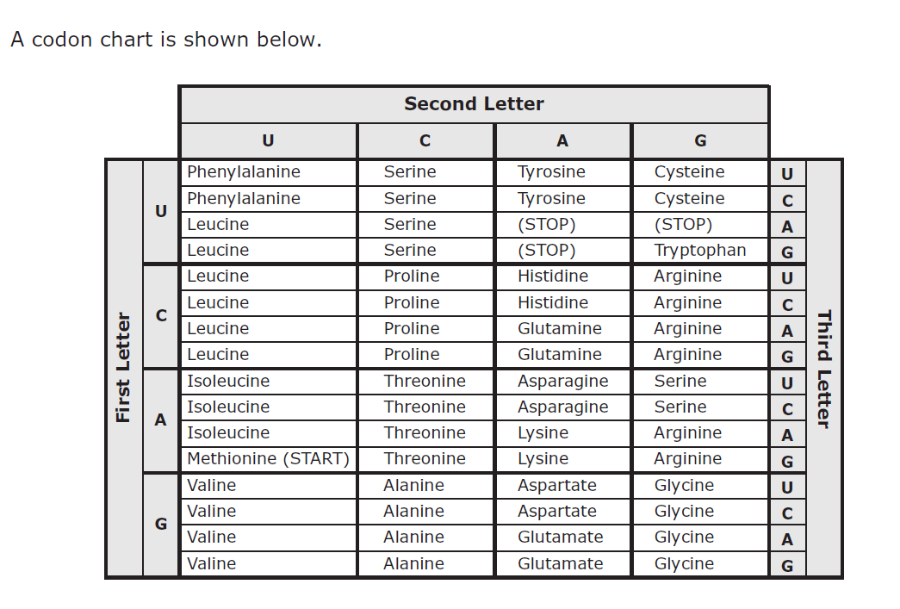
Which of these changes to the DNA triplet 3’ GCT 5’ will affect the
protein produced?
A GTT
B TCT
C TCC
D GCA
22
a
Which of the following correctly describes an interaction that occurs
between two body systems of a rabbit that helps the rabbit outrun a
pursuing coyote?
F The skeletal system releases additional
calcium, and the circulatory system retains more sodium in the blood
to provide muscles with ions for contraction.
G The digestive
system increases the rate of digestion, and the excretory system
ceases to provide tissues with more nutrients.
H The respiratory
system increases the breathing rate, and the circulatory
system
increases blood pressure to provide tissues with more
oxygen.
J The endocrine system releases hormones that prepare the
immune system to deal with possible injuries.
h
Proteins and polysaccharides are polymers. These polymers are formed
by dehydration synthesis. Which statement correctly identifies a
difference in the structure of proteins and polysaccharides?
F
Only polysaccharides are comprised of repeating units of cytosine,
adenine, guanine, and thymine.
G Only proteins are formed from
amino acids joined by peptide bonds.
H Only polysaccharides can
be folded and twisted to very specific shapes.
J Only proteins
can be large molecules with thousands of subunits.
g
Both euglena and cyanobacteria are photosynthetic unicellular
organisms found in pond water. The feature that distinguishes euglena
from cyanobacteria is the —
A ability to maintain
homeostasis
B presence of ribosomes
C ability to
reproduce
D presence of a nuclear membrane
d
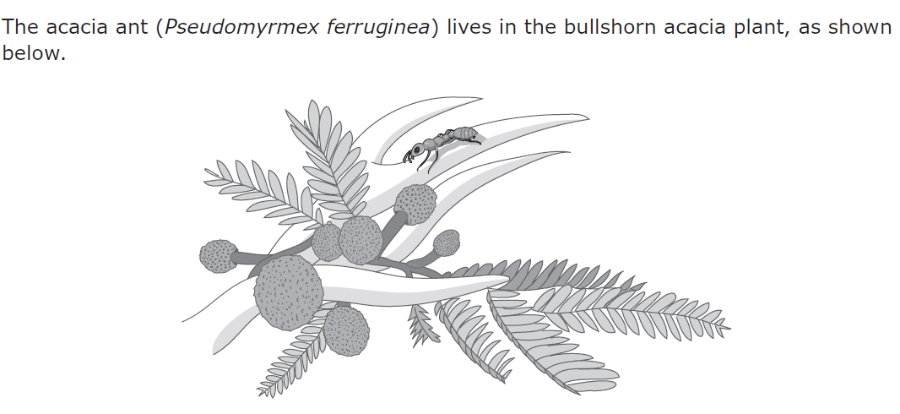
The acacia ant nests and feeds in the plant’s hollow thorns. The ant
helps protect the bullshorn acacia by attacking insects and grazing
animals that come near the plant. The relationship between the acacia
ant and the bullshorn acacia is an example of which of the
following?
F Commensalism
G Mutualism
H
Neutralism
J Parasitism
g
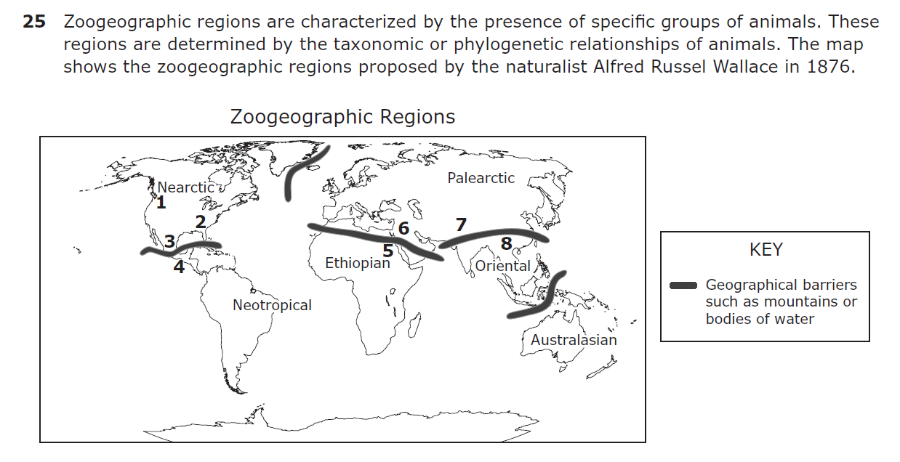
The similarities of organisms in which two areas numbered above
provide the best evidence
for common ancestry between the
organisms in both locations?
A 1 and 2
B 3 and 4
C 5 and 6
D 7 and 8
a
Crossing-over between nonsister chromatids during meiosis is
significant in heredity. This process most likely leads to an increase
in which of the following?
F The expression of dominant
traits
G Number of gametes
H The occurrence of
polyploidy
J Genetic variation
j
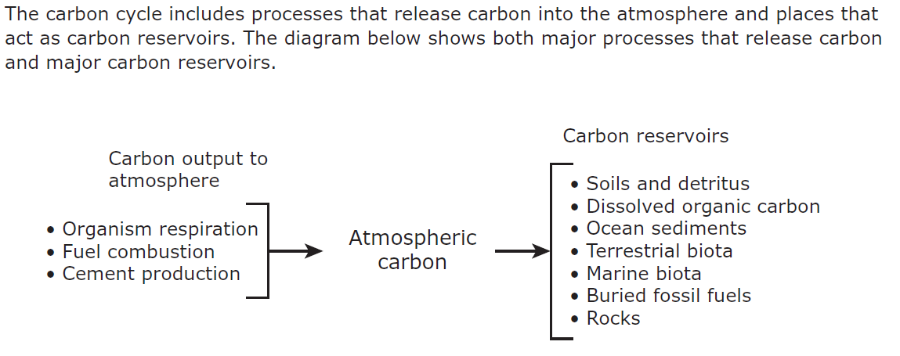
Which of these disruptions would cause an excess output in the carbon
cycle?
A The destruction of terrestrial biota
B Increases in
marine biota
C A reduction in the use of fossil fuels
D A
thickening of ocean sediments
a
Arthropods are joint-legged animals. Spiders, crabs, pill bugs,
centipedes, and millipedes are examples of the many types of
arthropods. Which of these arthropods are most closely related?
F
Arthropods of the same family
G Arthropods of the same
class
H Arthropods of the same genus
J Arthropods of the
same species
j
Which cellular process takes place in the ribosomes that are bound to
the endoplasmic reticulum?
A The breakdown of waste
material
B The conversion of radiant energy to glucose
C The
synthesis of new proteins
D The replication of nucleic acids
c
Characteristics such as a widow’s peak or attached earlobes are
determined by the genetic code. Which components of DNA are referred
to as the genetic code?
F Phosphate groups
G Nitrogenous
bases
H Deoxyribose sugars
J Hydrogen bonds
g
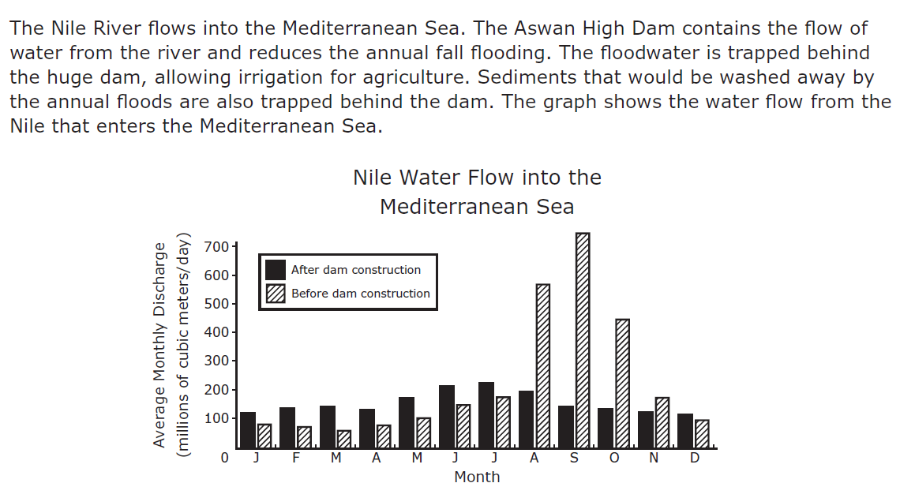
How has this dam most likely affected the Mediterranean Sea
ecosystem?
A Reduced nutrients from the land support fewer
producers in the sea.
B Water trapped behind the dam causes the
marine ecosystem to move inland.
C The flooding in August through
November causes marine life to be destroyed.
D The water
temperature of the sea has increased.
a
Plant hormones serve as chemical messengers between cells and
tissues. Auxin is a plant hormone that causes the cells on the shady
side of a plant shoot to elongate. The response enabled by auxin is
known as —
F geotropism
G transpiration
H
phototropism
J photosynthesis
h
Which of these must occur during S phase of the cell cycle so that
two daughter cells can be produced during M phase?
A The DNA must
be replicated.
B The chromosomes must be joined.
C The
cytoplasm must be separated.
D The cell membrane must be expanded.
a
After examining the fossil record, scientists have determined that
scorpions today are much smaller than their extinct ancestors. For
example, Jaekelopterus rhenaniae, a giant scorpion species that lived
255 million to 460 million years ago, was 2.5 meters long. Which of
the following conclusions is supported by this information?
F
Scorpions living today have increased their numbers since they first
appeared.
G Scorpions in the fossil record are smaller than their
descendants are.
H Scorpions have changed as a result of natural
selection.
J Scorpions do not appear in their original state in
the fossil record.
h
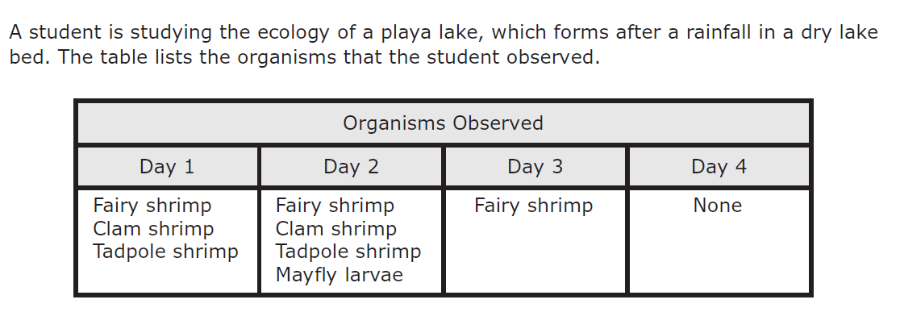
Which level of biological organization has the student described in
the table?
A Biosphere
B Organelle
C Ecosystem
D Community
d
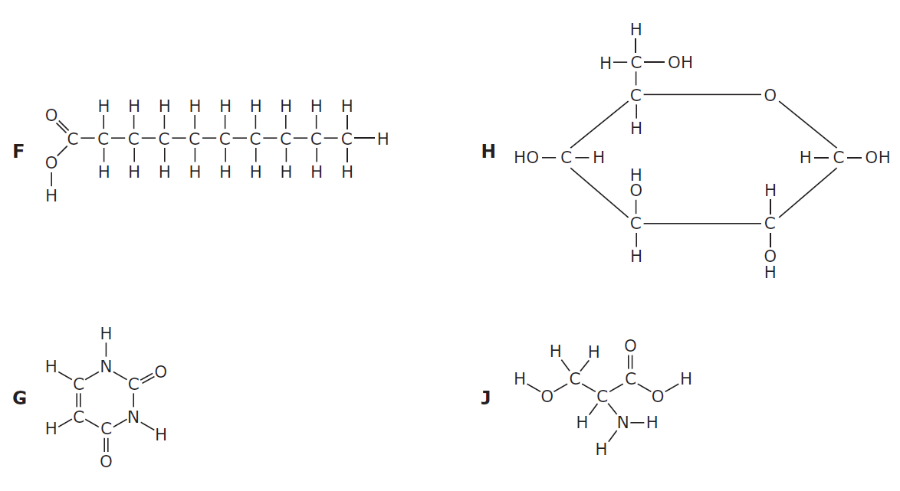
Which of these best represents a fatty-acid molecule?
f
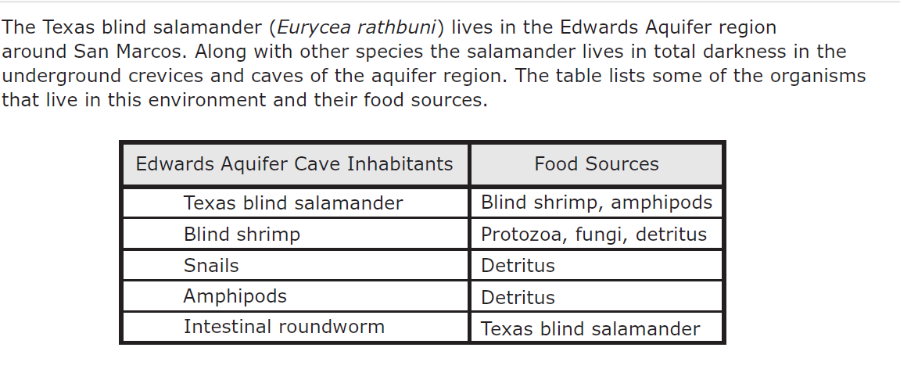
In an energy pyramid for these aquifer cave dwellers, which of the
following would be placed at the bottom?
A Snails
B Blind shrimp
C Protozoa
D Texas blind salamanders
c
In cocker spaniels the allele for a black coat color (B) is dominant
over the allele for a brown coat color (b). If a brown cocker spaniel
is crossed with a heterozygous black cocker spaniel, which of the
following genotypic ratios can be expected?
F 0 BB: 2 Bb: 2
bb
G 1 BB: 2 Bb: 1 bb
H 2 BB: 0 Bb: 2 bb
J 2 BB: 1 Bb:
0 bb
f
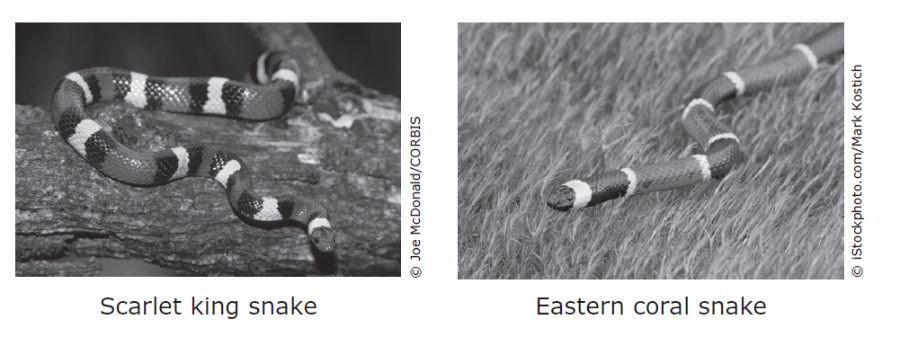
A harmless scarlet king snake and a venomous eastern coral snake have similar band patterns, as shown below. For the scarlet king snake, the adaptation of having a banding pattern like the eastern coral snake’s is known as mimicry.
The outcome of this adaptation in the scarlet king snake is to
—
A make it easier for the scarlet king snake to attract
prey
B make it easier for the scarlet king snake to interbreed
with the other snake
C allow the scarlet king snake to blend in
with its environment
D protect the scarlet king snake from predators
d
A student sets up a compost bin outdoors. Inside the bin
microorganisms convert the student’s vegetable and paper scraps into
rich fertilizer. Which of the following best describes the role that
these microorganisms play in natural habitats?
F The
microorganisms help balance the numbers of producers and
consumers.
G The microorganisms help keep nutrients cycling
through the ecosystem.
H The microorganisms turn solar energy
into sugars.
J The microorganisms function as autotrophs.
g
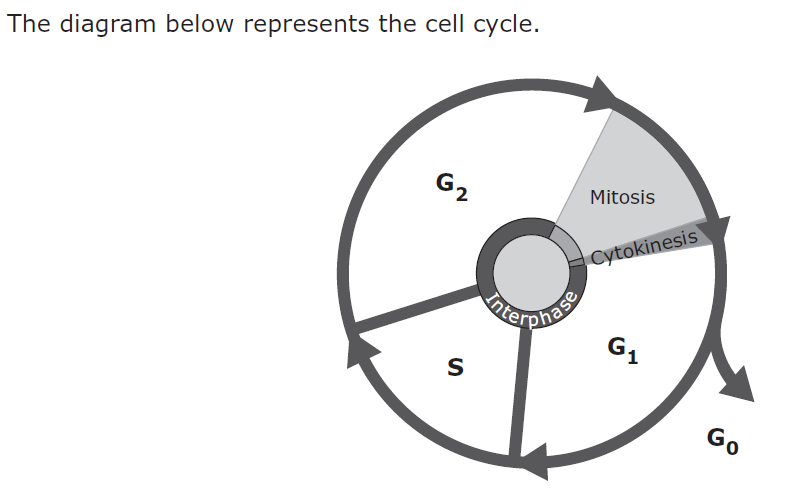
When cells leave the cell cycle, they exit during G1 phase
and then enter G phase, a resting period. Most normal cells can leave
G0 phase and reenter the cell cycle at G1 phase
before entering S phase. Cancer cells are different because they
cannot enter G0 phase and are likely to do which of the
following?
A Fail to complete S phase
B Mutate during G phase
C Repeat the cell cycle continuously
D Die after completing mitosis
c
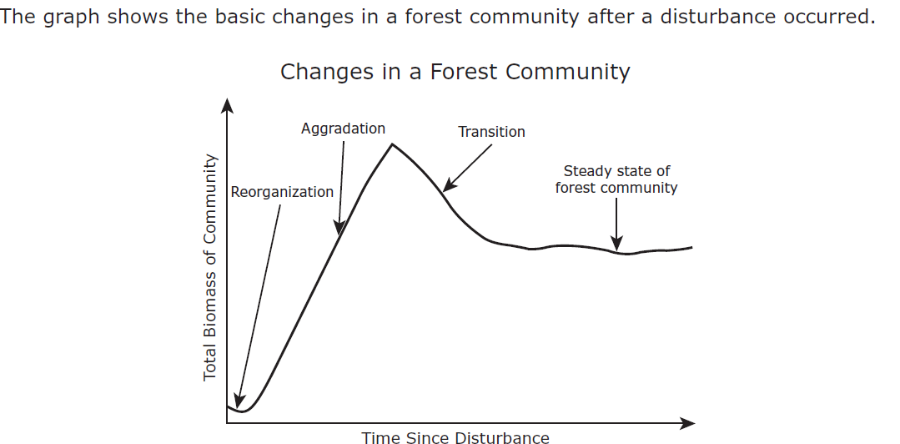
The information shown in the graph suggests that the changes in the
forest community were
caused by —
F tree-leaf replacement
after a storm
G succession after a fire
H repeated habitat destruction
J decreased species diversity
g
How does DNA in cells determine an organism’s complex traits?
A
DNA contains codes for proteins, which are necessary for the growth
and functioning of an organism.
B DNA separates into long single
strands that make up each part of an organism.
C DNA produces the
energy an organism needs in order to grow.
D DNA folds into the
nucleus of each of the cells of an organism.
a
Copper is a micronutrient that can be found in soil. Copper is
important for reproductive growth in plants and plays an indirect role
in chlorophyll production. Which statement correctly describes the
interaction that occurs between the root and the shoot systems of
plants to allow reproduction to occur?
F Copper is produced in
the roots when copper-containing compounds are hydrolyzed.
G
Copper that is absorbed by the roots is transported to reproductive
tissues by the shoot system.
H The shoot system stores copper for
later use by the roots and the reproductive
structures.
J
The shoot system transports copper to the roots after it is taken in
through stomata in the leaves.
g
Cold sores are caused by the herpes simplex virus type 1. A company
that wants to develop antiviral drugs would ask a research
immunologist to study —
A the mechanism used by the virus to
infect cells
B how closely related the virus is to cold
viruses
C the metabolism of the virus
D meiosis in the virus
a
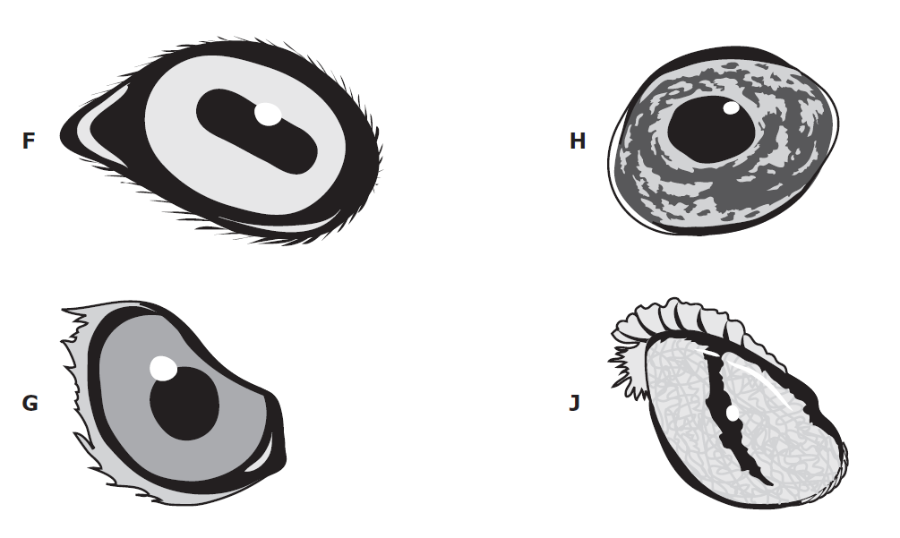
The iris controls the size and shape of the pupil. Which eye most likely belongs to an animal that is active most of the day on white desert sand?
j
Cell differentiation is critical during embryonic development. The
process of cell differentiation results in the production of many
types of cells, including germ, somatic, and stem cells. Cell
differentiation is most directly regulated by —
A ATP
B
DNA
C lipids
D sugars
b
The human digestive system is approximately 900 cm long. Food is
moved through the digestive tract primarily by —
F bile produced
by the pancreas
G the enzymes amylase and pepsin
H muscular
contractions
J hydrochloric acid in the stomach
h
The fact that a strain of yeast with a certain defective gene can use
the human version of the gene to repair itself is evidence that yeast
and humans —
A depend on the same food supply
B share a
genetic code
C both have eukaryotic cells
D have identical genomes
b
A native species and a non-native species are competing for resources
within the same ecosystem. The non-native species is more likely to
survive than the native species in which of the following
situations?
F Both the native species and the non-native species
thrive on the same food source.
G The native species is immune to
certain pathogens in the ecosystem.
H Predators prey on both
native and non-native species.
J The non-native species has no
natural enemies in the ecosystem.
j
Changes in water pressure within guard cells cause the cells to open
or close the stoma. This response helps the plant maintain homeostasis
by —
A stabilizing the plant’s temperature through the
evaporation of water
B regulating the amount of water the plant
loses during transpiration
C allowing oxygen needed for
photosynthesis to enter the plant
D enabling the plant to release
more carbon dioxide at night for photosynthesis
b
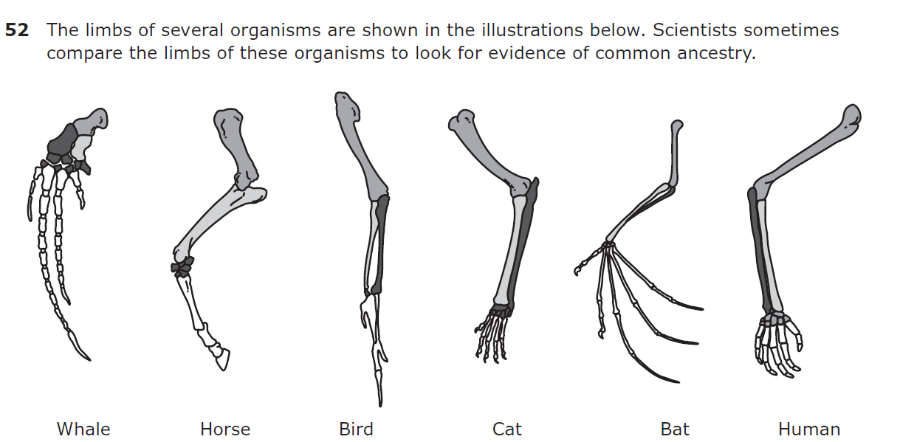
These limbs provide evidence of common ancestry because they —
F
have the same basic structure
G perform the same function
H
are the same size
J are parts of mammals
f
A mutation that occurs in the gametes of an organism will most likely
be transferred to whichvof the following?
A The siblings of the
organism
B The offspring of the organism
C The other
organisms living nearby
D The mating partner of the organism
b
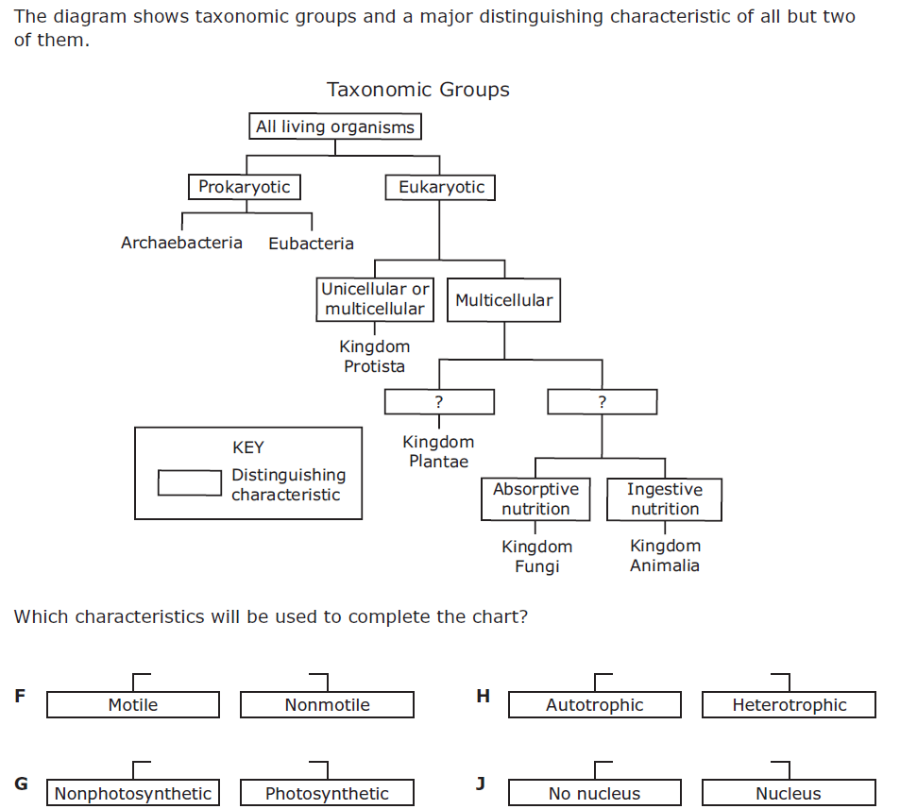
h
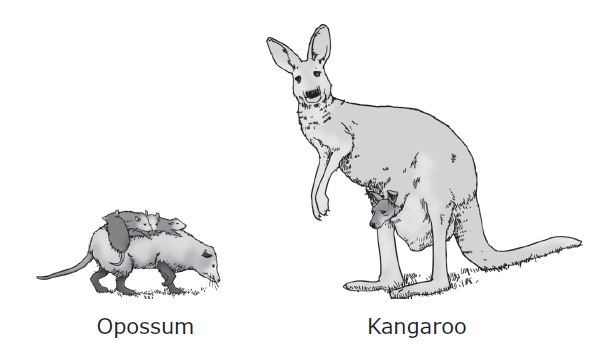
The opossum, which is native to North America, and the kangaroo, which is native to Australia, are marsupials.
The fact that both these mammals incubate their immature offspring in a pouch provides evidence that they —
A belong to the same species
B must range great distances to eat
C have very similar skeletal structures
D are descended from a common ancestor
d
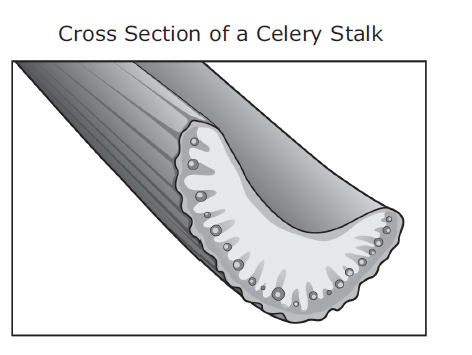
Some students are instructed to put a celery stalk in a red dye solution for a lab activity. First the students carefully cut the bottom of the stalk with a scalpel. Then they put the stalk in the beaker with the solution and place the beaker on a shelf in the lab room. The next day they check the stalk and make observations. The students note that the leaves at the end of the stalk have changed color from green to red. The students cut across the celery stalk and use a hand lens to see that the small tube openings along the edge of the celery stalk are also red. The cross section is shown below.
How do the plant systems work together to make this movement of liquid possible?
F The roots absorb water and minerals and move them up to the stem, while the stem moves food produced in the leaves down to the roots in tiny tubes.
G The roots anchor the plant in the soil, and the stem holds the leaves up.
H The roots absorb their own water and minerals, while the stem absorbs its water and minerals through the leaves.
J The roots lose water vapor to the soil, and the stem loses water vapor through the leaves.
f
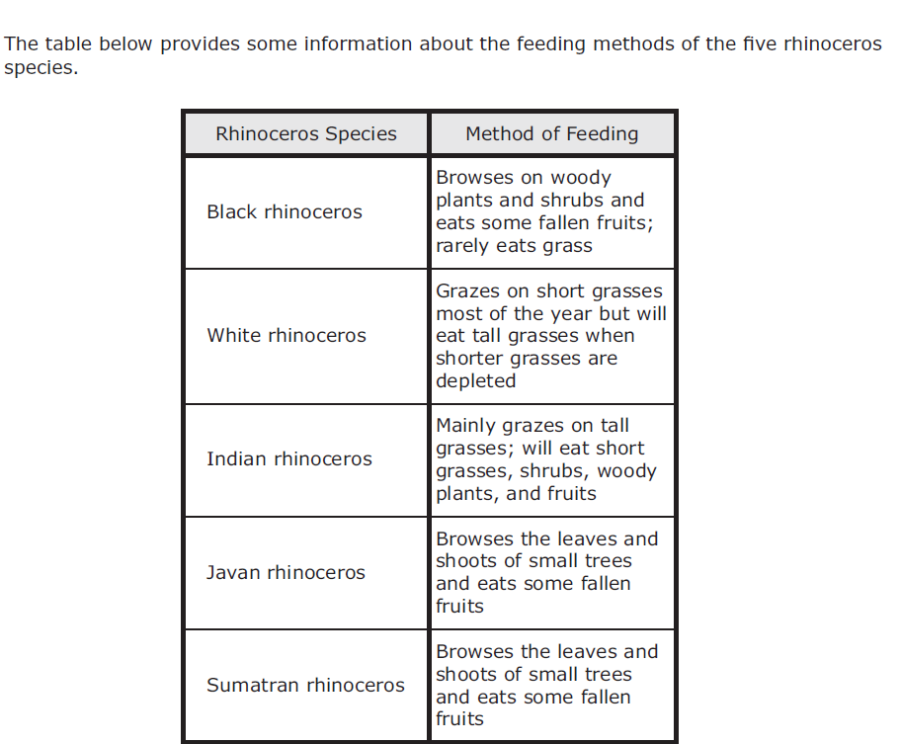
Which rhinoceros species is best adapted for feeding in the large open grasslands of Africa’s Serengeti ecosystem?
A Black rhinoceros
B White rhinoceros
C Sumatran rhinoceros
D Javan rhinoceros
b
Early-onset Alzheimer’s disease affects people under the age of 65. Less than five percent of people who are diagnosed with Alzheimer’s disease have this type. Many cases of early-onset Alzheimer’s disease are inherited, a type known as familial Alzheimer’s disease (FAD). Which statement is best supported by this information?
F FAD is the result of a genetic change in one or more chromosomes.
G Natural selection will continue to reduce the incidence of FAD.
H FAD affects only the genes of middle-aged people.
J Deletion of one amino acid causes FAD.
f
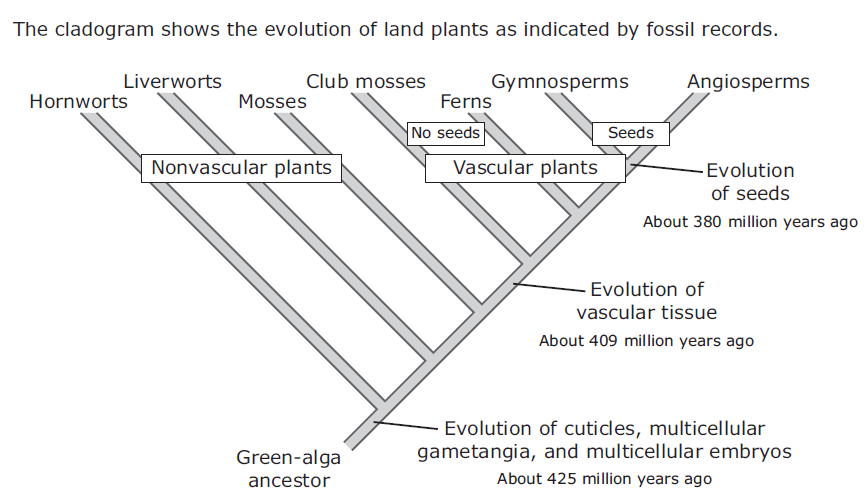
Which discovery would challenge the validity of this cladogram?
A A large aquatic vascular plant about 200 million years old
B A species of algae that has existed for less than one million years
C A moss species that has existed for less than 380 million years
D A fossil of a fern more than 425 million years old
d
Atherosclerosis is a disease that obstructs blood flow and, therefore, oxygen supply to target organs. A major component of atherosclerosis is the excessive reproduction of smooth muscle cells of the blood vessels. Certain drugs may have the potential to reverse or prevent the unregulated reproduction of the diseased blood-vessel cells. Which of these processes is the most likely target of these drugs?
F Cell division
G Erythroblast differentiation
H DNA transcription
J Cellular respiration
f
The outermost layer of plant stems in dicotyledons consists of epidermal cells and guard cells that surround openings called stomata. The epidermal cells are usually covered with a waterproof layer that provides protection from injury and water loss. The stomata allow gas exchange. The epidermal cells and stomata have functions similar to those of which two human body systems?
A Skeletal and respiratory
B Cardiovascular and skeletal
C Integumentary and respiratory
D Cardiovascular and integumentary
c
Carbohydrates are more easily metabolized than lipids. However, on a gram-for-gram basis lipids provide cells with more —
F nitrogen
G proteins
H structure
J energy
j
Lord Howe Island is a volcanic island in the Tasman Sea that is about 11 km long and 2.8 km wide. The island has two species of palm trees, Howea forsteriana and the more abundant Howea belmoreana. The two species do not interbreed even when they grow very close to each other. Which evolutionary process fails to occur?
A Genetic drift of Howea forsteriana
B Natural selection of adaptive traits in both species
C Gene flow between the two species
D Mutations in Howea belmoreana
c
Dead zones are low-oxygen areas that develop on the seafloor. Scientists hypothesize that phytoplankton blooms cause these dead zones. Phytoplankton blooms occur when excess nutrients are introduced by pollution from fertilizers, sewage plants, and the burning of fossil fuels. Which of the following would most likely cause an increase in these contributors to dead zones?
F Rainfall patterns that increase freshwater runoff from terrestrial ecosystems
G Replacing coal-fired power plants with windmills
H Farming practices that reduce nitrate and phosphate applications
J Constructing efficient water-recovery and treatment plants
f

Based on the observations of the student, which organisms most likely belong to the taxonomic group for bacteria?
A Organisms 1 and 2
B Organisms 3 and 4
C Organisms 1 and 4
D Organisms 2 and 3
d
Sexual reproduction in animals depends on the production of gametes. Which of these processes produces gametes in animals?
F Mitosis
G Fertilization
H Meiosis
J Binary fission
h
What two human systems work together to provide body cells with a constant supply of oxygen while removing carbon dioxide waste products?
A Nervous and endocrine
B Muscular and skeletal
C Respiratory and circulatory
D Excretory and integumentary
c
Some fungi secrete substances that are toxic to bacteria that compete with them for food. Scientists have used their knowledge of this ability of fungi in order to produce which of the following substances?
F Yogurt
G Fertilizers
H Plastic
J Antibiotics
j
A person infected with the human immunodeficiency virus (HIV) may not have any symptoms for a period of time. During this period the virus affects the body by doing which of the following?
A The virus produces toxins that weaken immune cells and prevent them from reproducing.
B The virus damages immune cells while using their machinery to produce copies of itself.
C The virus uses nutrients meant for immune cells to fuel its own cellular respiration.
D The virus changes the identity of the nucleotides of immune cells to prevent the immune system from functioning normally.
b
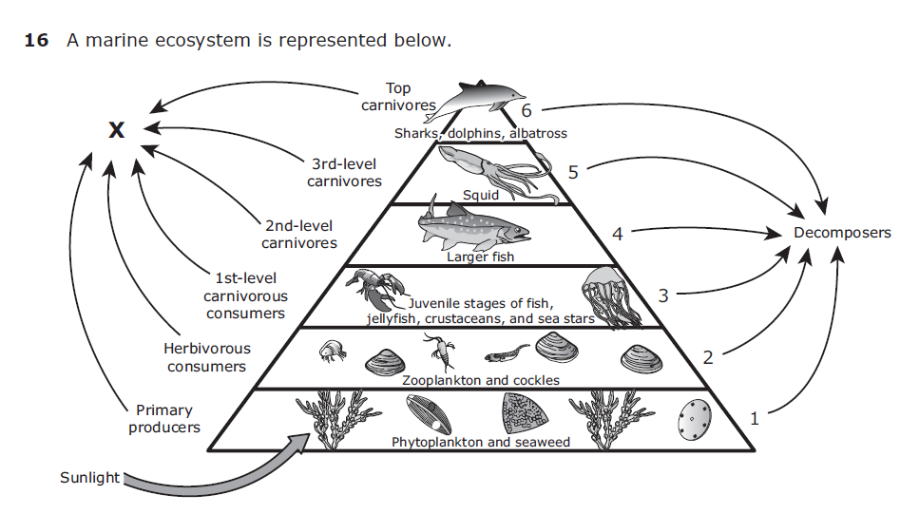
What is lost to the environment at each of the trophic levels of this ecosystem?
F Nutrients from the soil
G Living space for the organisms
H Food sources
J Heat
j
The sequence of nitrogenous bases in DNA varies widely. The sequence of the bases in DNA is most important for which of the following?
A Providing the instructions for the traits of an organism
B Preventing mutations from occurring during DNA replication
C Allowing the DNA to have the shape necessary for replication
D Helping form the sugar-phosphate backbone of DNA molecules
a
Which of the following functions at the same organizational level as the kidney in the human excretory system?
F Skeleton
G Epithelial tissue
H Urinary bladder
J A squamous cell
h
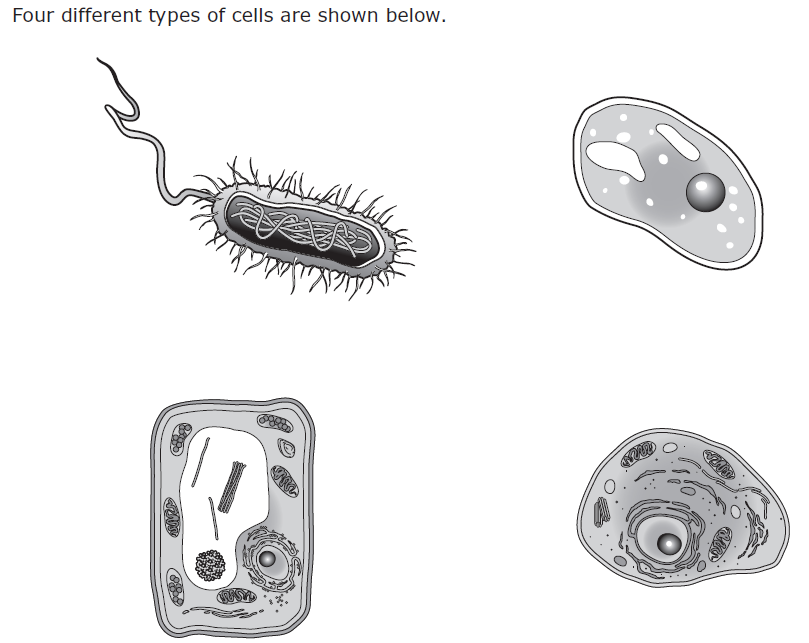
Which characteristic is shared by all four cells?
A A mechanism for transforming sunlight into energy
B Self-locomotion
C Membrane-bound organelles that transport substances
D Genetic material composed of DNA
d
Scientists estimate that there are more than 20,000 species of ants. The species range in size from 1 mm long to 38 mm long and live in most environments. The diets of ants range from flowers and seeds to fluids from their own larvae. Ants have been able to successfully inhabit so many different environments because their populations have been able to —
F hybridize with other species of insects
G adapt to a variety of habitats and food sources
H fill niches usually occupied by mammals
J occupy habitats that have no other life-forms
g
This process is an example of which of the following?
A The role of the endocrine system in increasing the oxygen content of red blood cells
B Control of urine production by the parasympathetic nervous system
C Maintenance of homeostasis by a feedback mechanism
D Disruption of homeostasis by exercise
c
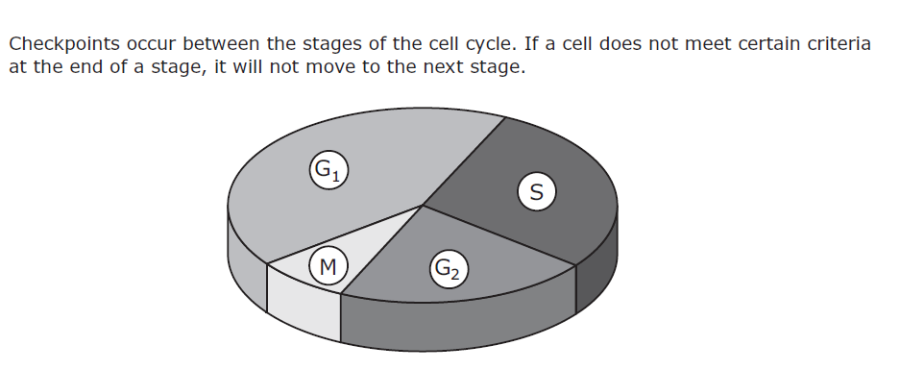
Which of these occurs just before the cell enters the G2 stage of the cell cycle?
F The nuclear membrane disintegrates.
G DNA replicates.
H Centrioles form.
J The nucleolus divides.
g
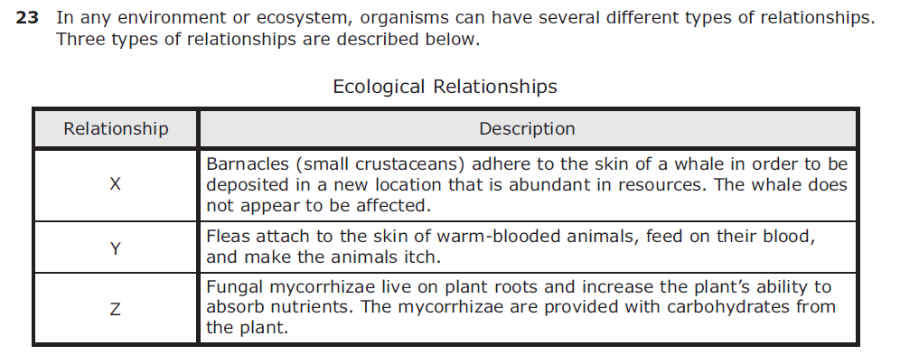
Which of these correctly describes the relationships between the
organisms?
A X: mutualismY: parasitism Z: commensalism
B X:
commensalismY: mutualism Z: parasitism
C X: parasitismY:
commensalism Z: mutualism
D X: commensalismY: parasitism Z: mutualism
d
In the 1860s Gregor Mendel performed numerous dihybrid crosses between pea plants. Dihybrid crosses involve the study of the inheritance patterns related to two different traits. In guinea pigs the allele for black fur (B) is dominant over the allele for brown fur (b), and the allele for short fur (F) is dominant over the allele for long fur (f). What percentage of the offspring from a BbFf x bbff cross would be expected to be heterozygous for both traits?
F 0%
G 25%
H 50%
J 100%
g
Hydrothermal vents form deep in the ocean when iron-rich magma is released from openings on the seafloor. These vents spew extremely hot water (400°C) mixed with methane and sulfur. Bacteria that thrive in this hostile environment form the base of a food chain that leads to colonization by tube worms, mussels, and many other life-forms. When a hydrothermal vent becomes inactive and cold, the bacterial community that lives in the hot fluid methane and sulfur dies out. Which organisms most likely succeed the original community in this ecosystem?
A Cold-tolerant bacteria that feed on sulfur and iron in the vents
B Giant kelp that use sulfur in photosynthesis
C Fish that do not need oxygen for cellular respiration
D Ocean mammals that tolerate cold and act as top predators in the food chain
a
When a person is suddenly cut by a sharp object, a nervous impulse is sent along a sensory neuron to the spinal cord. The impulse is immediately transmitted through motor neurons to produce a response. Which of the following correctly identifies and describes this response?
F It is a conditioned response that occurs only to prevent injury.
G It is a learned response that does not occur in infants and small children.
H It is a reflex response that causes various muscles to contract in order to move away from the object.
J It is a voluntary response that is initiated only after the impulse has been carried to the relevant area in the brain.
h
Which group of organelles is directly responsible for the production of new molecules within a cell?
A Ribosomes, the endoplasmic reticulum, and Golgi apparatuses
B Golgi apparatuses, lysosomes, and the plasma membrane
C The endoplasmic reticulum, plastids, and vacuoles
D The nucleolus, vacuoles, and ribosomes
a
In 1917 the biologist Thomas Hunt Morgan conducted studies in which he kept some caterpillars in the dark and placed some others under red, green, or blue lights. Exposure to red light produced butterflies with brightly colored wings. Exposure to green light resulted in dark-colored wings. Exposure to blue light or no light resulted in pale-colored wings. What was the most likely conclusion of Morgan’s research?
F The pigment in butterfly wings absorbs light from the environment.
G The phenotypic expression of wing shape depends on color pigmentation in butterflies.
H The genes regulating wing color in butterflies are influenced by environmental factors.
J Caterpillars exposed to red and green light are healthier than caterpillars exposed to no light or blue light.
h
Severe acute respiratory syndrome (SARS) is an illness caused by a coronavirus. Symptoms including a high fever, headaches, and body aches typically occur two to seven days after infection by the virus. SARS is more serious in elderly patients. This information suggests that the reproductive cycle of the SARS virus is —
A lysogenic, because the virus is a coronavirus
B lytic, because the virus causes respiratory illness
C lysogenic, because the virus primarily affects older people
D lytic, because of the quick onset of symptoms after infection
d

If Enzyme 2 is denatured, the levels of which substance will increase?
F Lactose
G Galactose
H Galactose-1-phosphate
J Glucose-6-phosphate
g
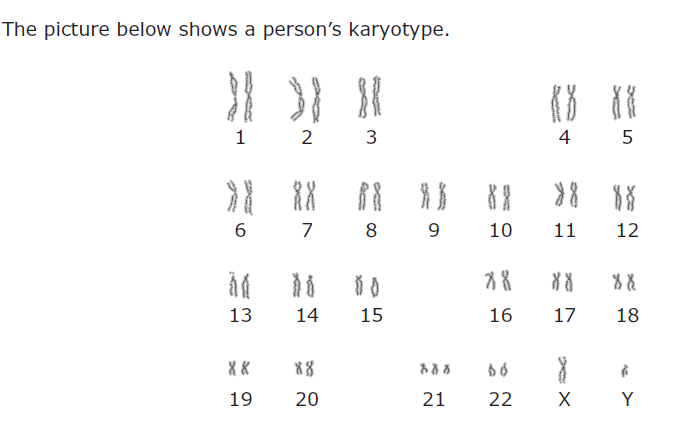
Which of the following can best be determined by examining this karyotype?
A The presence of an additional chromosome
B The presence of a homozygous genotype
C The person’s genome
D The person’s phenotype
a
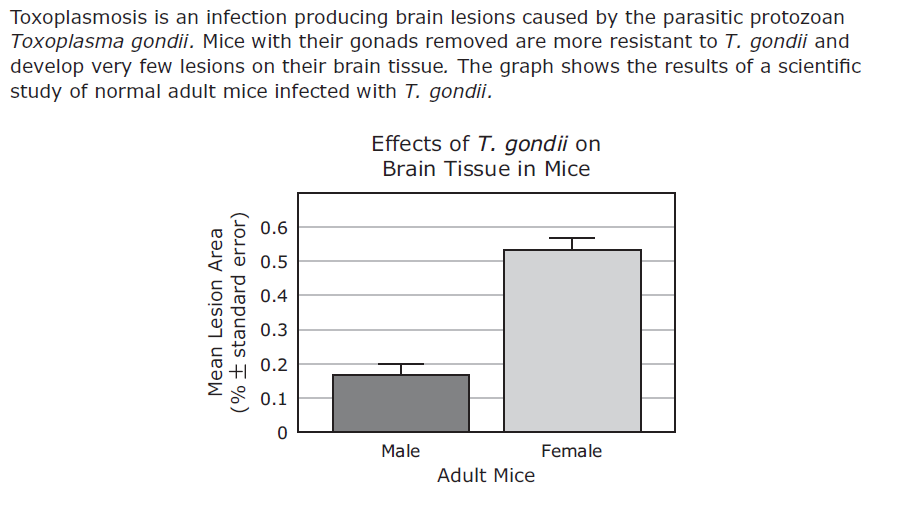
Which systems most likely interact and cause the severity of infections to vary?
F Muscular and skeletal
G Immune and endocrine
H Excretory and respiratory
J Nervous and integumentary
g
The cellular process known as the sodium-potassium pump was discovered in the 1950s by Jens Christian Skou, a Danish scientist. This process is a form of active transport that moves three sodium ions to the outside of a cell for every two potassium ions that it moves into the cell. Which of these best explains why energy is needed for active transport?
A Ions are negatively charged.
B Ions are attached to large proteins.
C Ions are trapped inside the plasma membrane.
D Ions are moved against the concentration gradient.
d
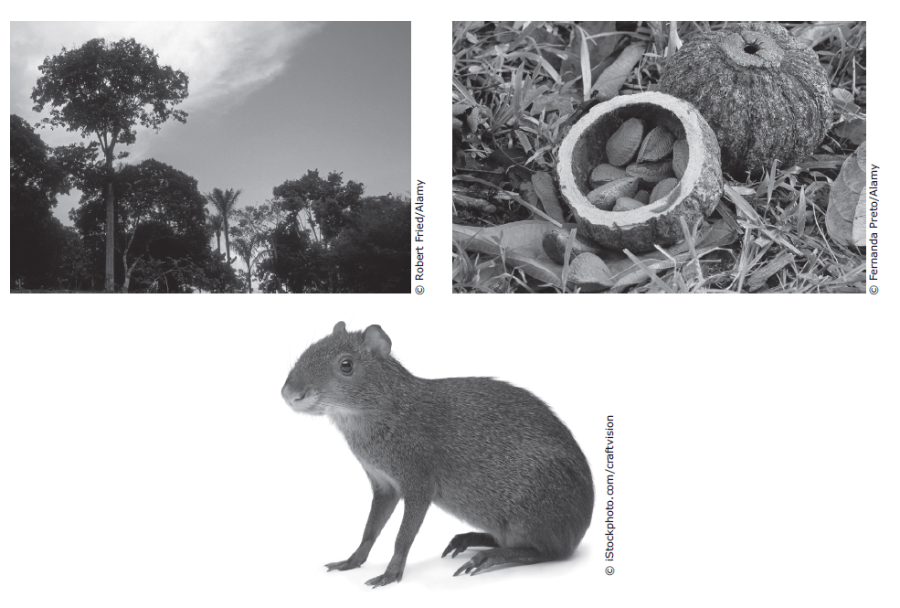
Brazil nuts (Bertholletia excelsa) are tall canopy trees that make up a large portion of the Amazon rain forest. They produce large grapefruit-sized seedpods. The agouti, a ground-dwelling rodent, has teeth strong enough to open the tough seedpods. While the agouti eats some of the tree’s seeds, it also buries caches in various spots on the rain forest floor.
Why is the agouti important to the rain forest ecosystem?
F It eats and disperses the trees’ seeds.
G It eats the trees’ excess seeds and prevents other animals from doing so.
H It cleans the rain forest floor of debris, allowing for easier motility.
J It prevents the trees’ seeds from rotting on the rain forest floor.
f
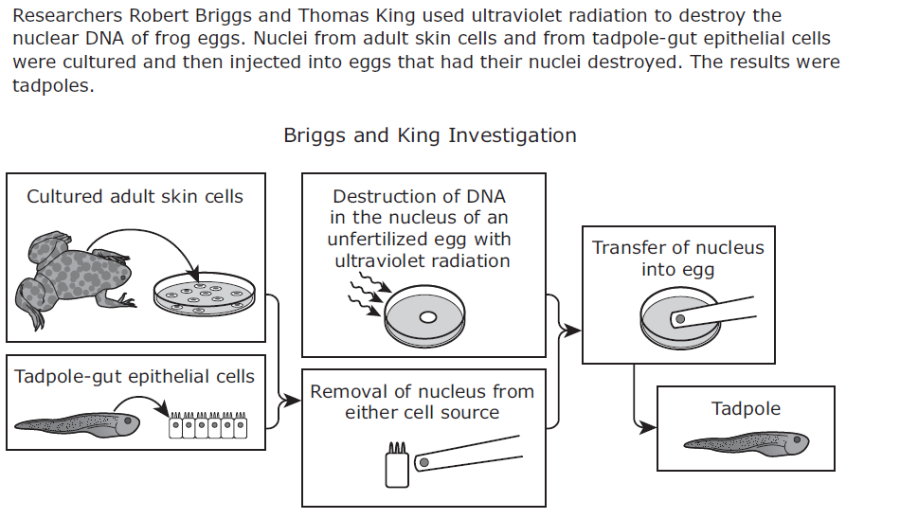
Which conclusion is supported by the data from this investigation?
A The DNA information for development was silenced in differentiated cells.
B The transplanted DNA functioned as the original nuclear DNA of the egg cell would have.
C The DNA from skin cells and epithelial cells was not transcribed.
D The transplanted DNA mutated during culturing.
b
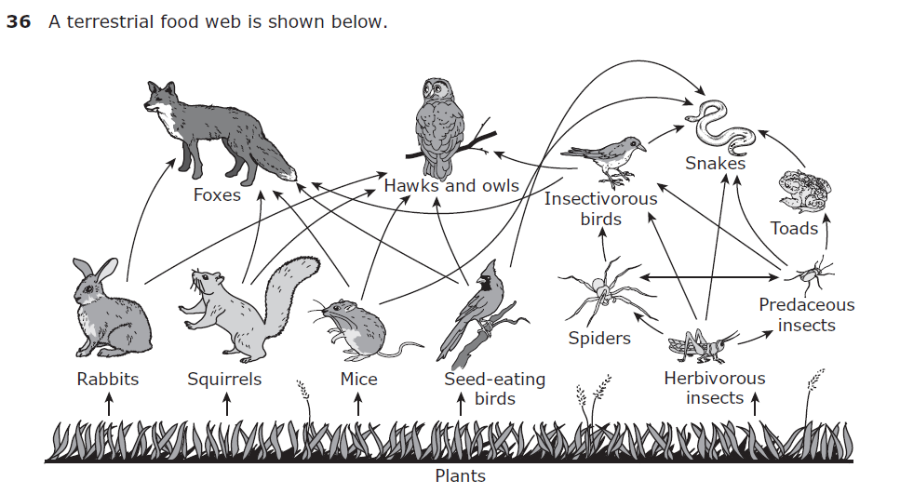
Which of the following lists only organisms that are secondary
consumers in this food web?
F Mice, rabbits, herbivorous insects,
and squirrels
G Predaceous insects, toads, spiders, and foxes
H Spiders,
foxes, owls, hawks, and snakes
J Insectivorous birds, seed-eating birds, owls, and hawks
h
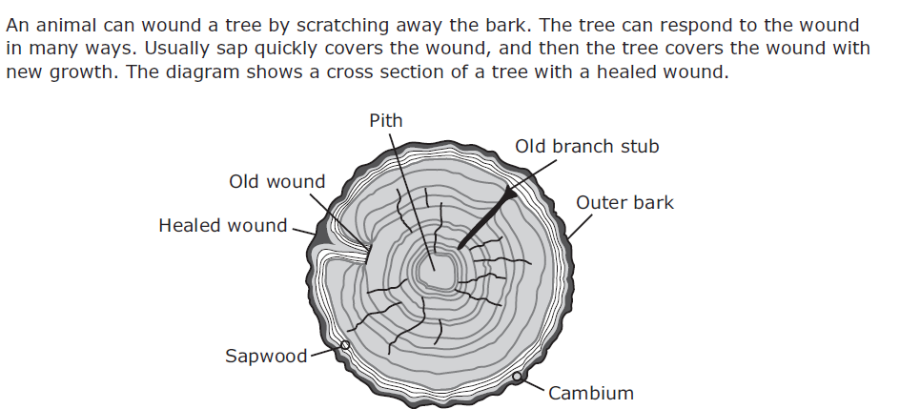
What process worked most directly with the transport system to heal the wound?A Cellular reproduction
B Photosynthesis
C Water intake
D Carbohydrate storage
a
The Linnaean taxonomic system classifies organisms into divisions called taxa. If two organisms belong to the same taxonomic group, they are related. Similarity at which of these levels indicates the closest relationship?F Kingdom G ClassH OrderJ Genus
j

What type of mutation is depicted in this sequence?
A Substitution
B Insertion
C Deletion
D Frameshift
a
In Madagascar scientists have discovered a moth, Xanthopan morganii praedicta, that has a 30.5 cm proboscis and feeds from and pollinates Darwin’s orchid, Angraecum sesquipedale. The orchid has a nectar-producing tube that is 27.9 cm long.
How is the moth’s proboscis size an adaptation for its environment?
F The moth can avoid larger animals.
G The moth can pollinate other flowers.
H The moth has little competition for food.
J The moth has time to feed during the day.
h
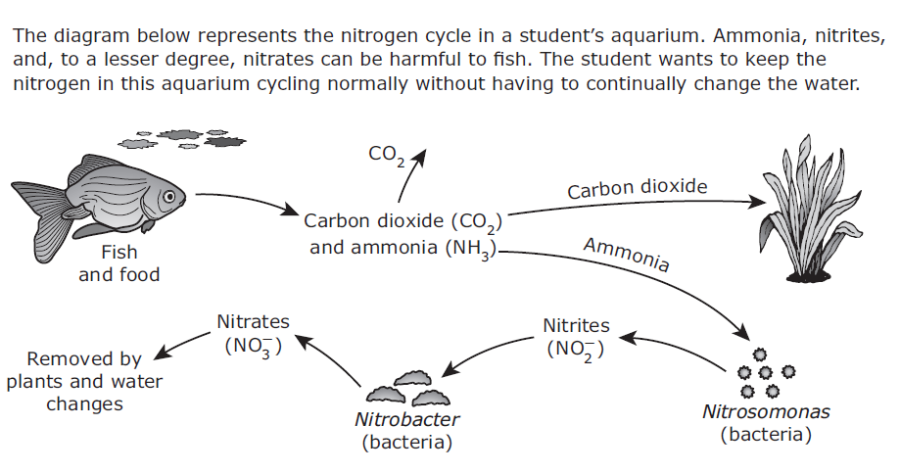
Which of the following should the student add more of to help remove nitrates and improve the natural cycling of nitrogen in this aquarium?
A Fish
B Plants
C Nitrobacter
D Water
b
Genome maps provide the DNA sequences of chromosomes. Some scientists have compared the genome maps of a hedgehog and a sloth. What do these genome maps allow the scientists to determine?
F The color patterns of the offspring of each species
G How much the size ranges of the two species differ
H The methods of protein synthesis that each species uses
J How closely related the two species are to each other
j
Tomato plants usually have hairy stems. Hairless stems are present in tomato plants that are homozygous recessive for this trait. If the stem characteristics are determined by a single gene, what is the expected outcome of crossing two tomato plants that are heterozygous for hairy stems?
A 75% hairy stems: 25% hairless stems
B 100% hairy stems
C 100% hairless stems
D 50% hairy stems: 50% hairless stems
A
44 Which of the following biomolecules typically contains both nitrogen and phosphate?
F Lipid
G Protein
H Nucleic acid
J Carbohydrate
H
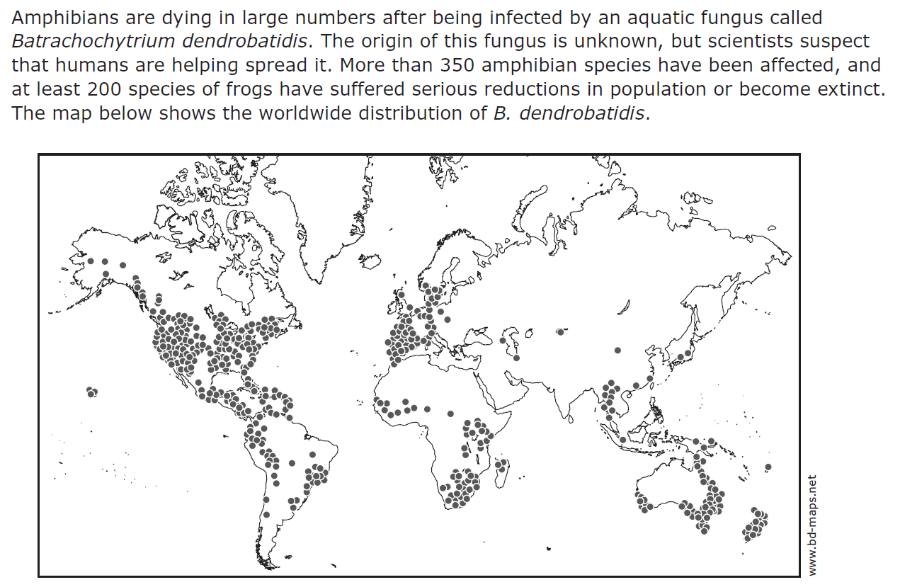
What will be the most likely impact of the decline in frog populations resulting from the fungal infection?
A New species of frogs that feed on both the fungus and the infected species of frogs will evolve.
B Plants will no longer grow in the waters of the affected ecosystems, and fish species will increase.
C The fungus will move on land and destroy reptile and mammal populations in tropical ecosystems.
D Populations of algae and mosquitoes will increase, leading to fish die-offs and potential increases in human malaria cases.
D
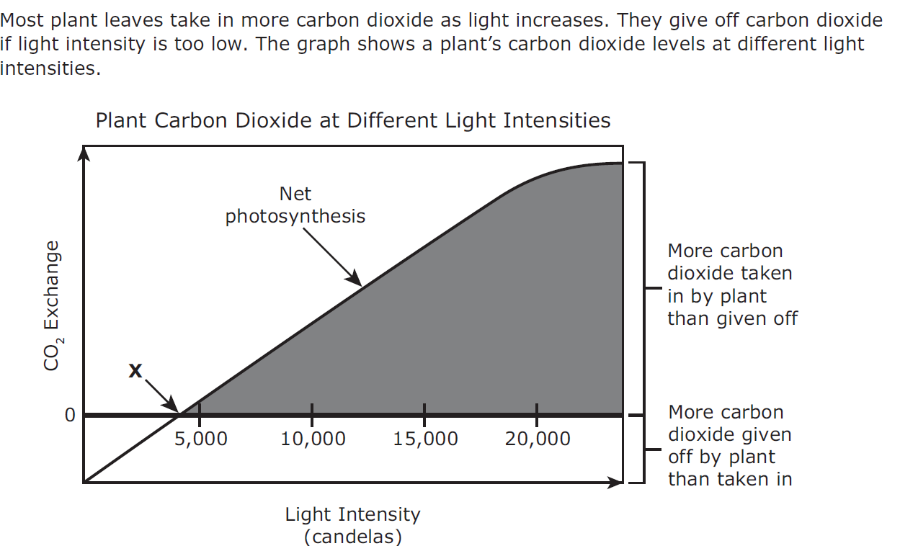
At point X, the rate of which process is equal to the rate of photosynthesis?
F Cellular respiration
G Transpiration
H Growth
J Reproduction
F
Telophase is a stage of a cellular process that begins after the chromosomes have moved to opposite poles of the cell. During which cellular process does telophase occur?
A Translation
B Interphase
C Transcription
D Mitosis
D
Which of the following polypeptides is coded for by the mRNA sequence 5'AUGGUUAAACGACAAUCC3'?
F Val, Lys, Phe, Gly, Ser
G Met, Asp, Phe, Ala, Arg
H Met, Val, Lys, Arg, Gln, Ser
J Ile, Gln, Lys, Asp, Gly, Leu, Ser
H
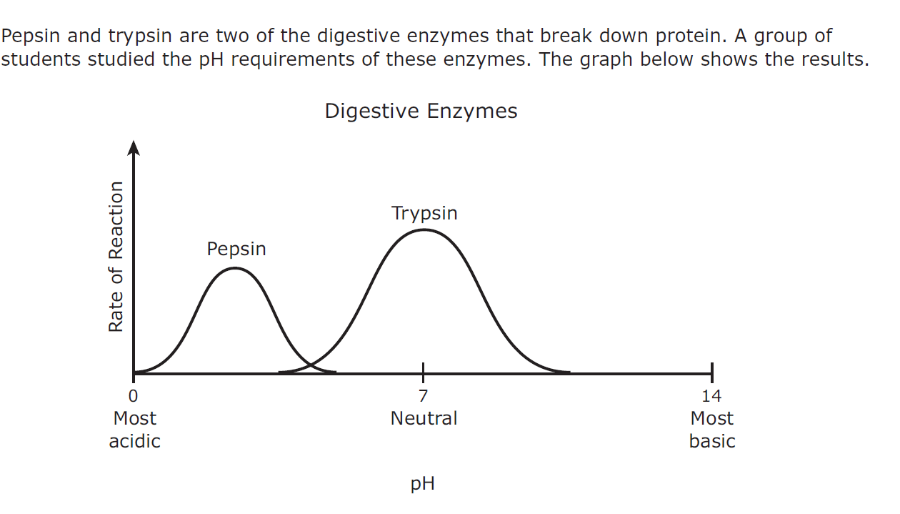
The students found that pepsin functions best in an acid environment and trypsin functions best in a neutral environment. Based on their observations, pepsin most likely aids in digestion in which part of the human body?
A Pancreas
B Intestines
C Mouth
D Stomach
D
Which condition is essential for natural selection to result in a new species?
F Unlimited resources
G An inherited variation
H A static environment
J A long life span
G
Most plants have hair-like cells called trichomes that project from the surface and help the plants in many ways. In some plants trichomes secrete toxic substances that most likely perform which function?
A Absorb carbon dioxide
B Protect against herbivorous insects
C Reflect light off leaves
D Reduce water loss from evaporation
B
By studying this photograph, scientists gained knowledge about the —F role of DNA in protein synthesis
G mutation of nucleotide sequences in DNA
H sequence of DNA that makes up the human genome
J double-helix structure of DNA
J
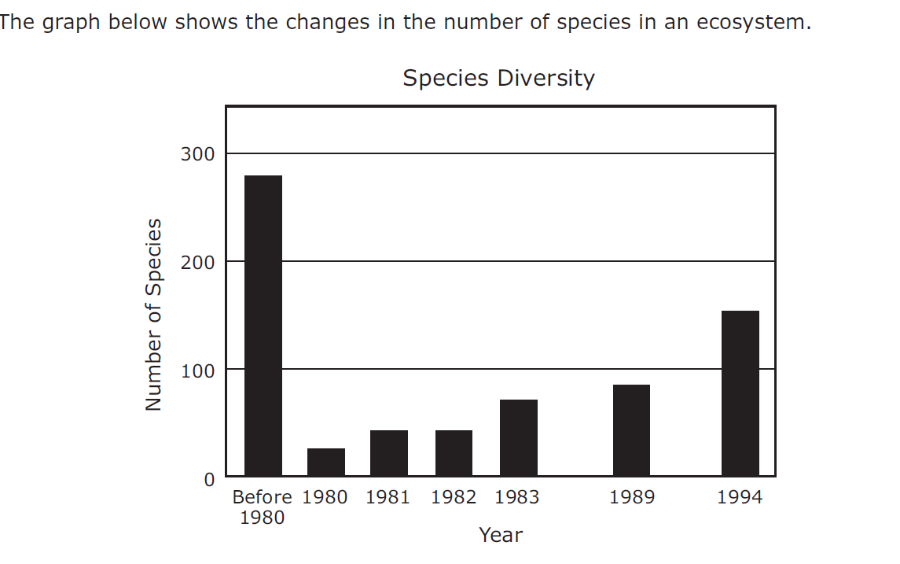
Which event was most likely the cause of the changes in species diversity in this ecosystem?
A A large volcanic eruption
B A flash flood
C A small tornado
D A migration of locusts
A
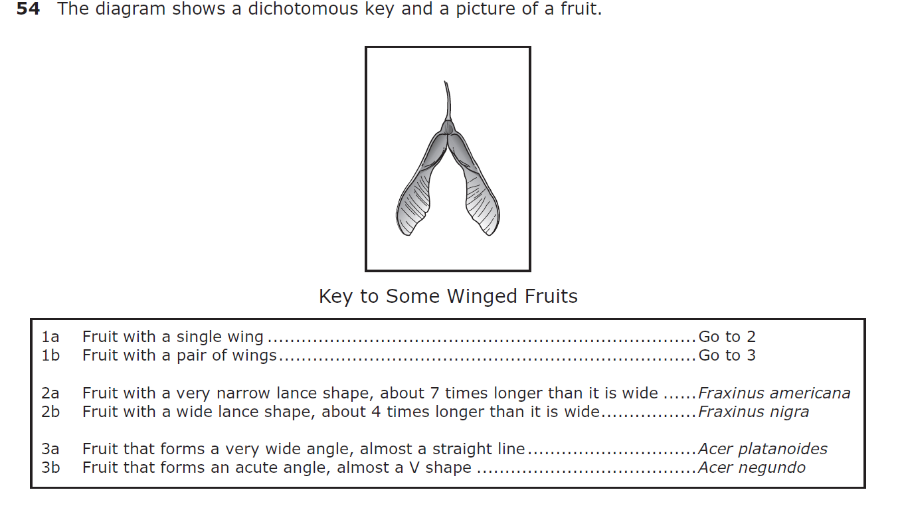
According to the key, the fruit comes from which species of tree?
F Fraxinus americana
G Fraxinus nigra
H Acer platanoides
J Acer negundo
J
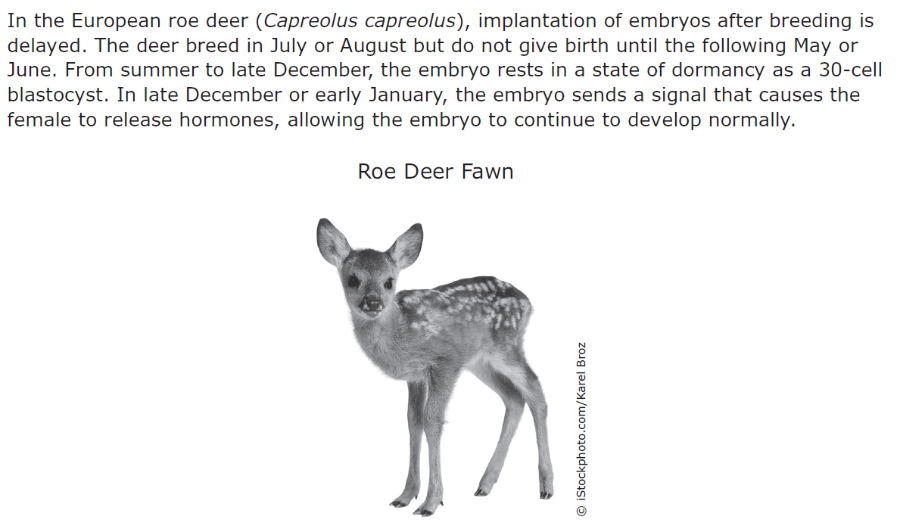
Why is delayed implantation an advantageous adaptation for the European roe deer?
A Delayed implantation allows the mother to continue to breed with other males.
B Without delayed implantation, the females would not be able to carry a pregnancy to full term.
C Delayed implantation enables the female to give birth to more fawns each year.
D Without delayed implantation, the fawns would be born in the winter when food is scarce and the weather is harsh.
D
Parrotfish are herbivores that are found in coral reefs. To escape predation, a parrotfish will graze with a rabbitfish, which has venomous spines at the end of its pelvic fins. The rabbitfish does not benefit from this relationship. Which type of relationship do the parrotfish and the rabbitfish have in the coral-reef environment?
F Commensal
G Mutualistic
H Predator–prey
J Parasitic
F
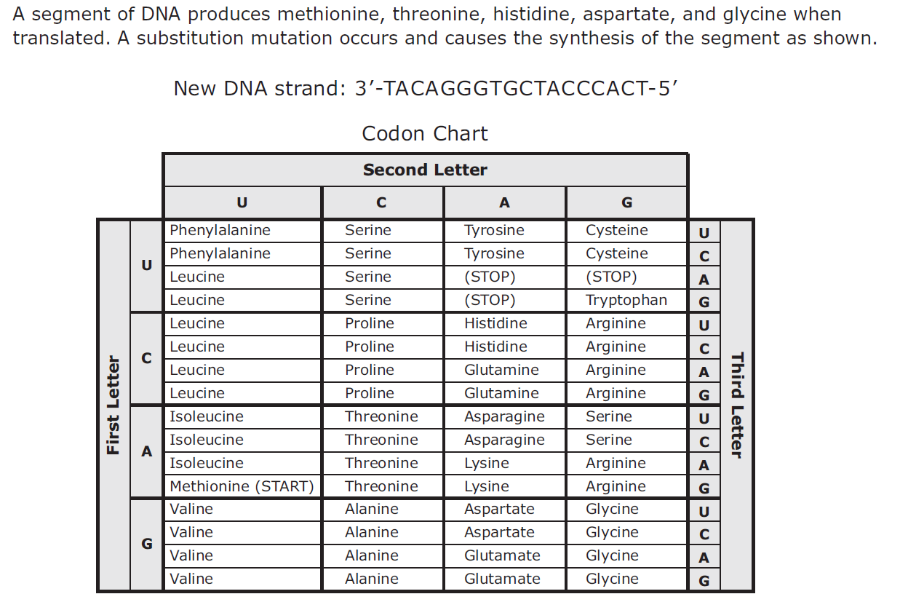
Which is the new peptide chain when the new DNA segment is translated?
A Methionine, leucine, histidine, aspartate, glycine
B Methionine, phenylalanine, histidine, aspartate, glycine
C Methionine, proline, histidine, aspartate, glycine
D Methionine, serine, histidine, aspartate, glycine
D
As ecosystems move through the stages of succession, the populations of organisms in them change. Which of the following describes the stage of succession likely to have the most species diversity?
F A newly formed volcanic island
G An agricultural field that has not been plowed for one year
H A temperate forest that has never been cleared by logging
J A field that is regularly mowed
H
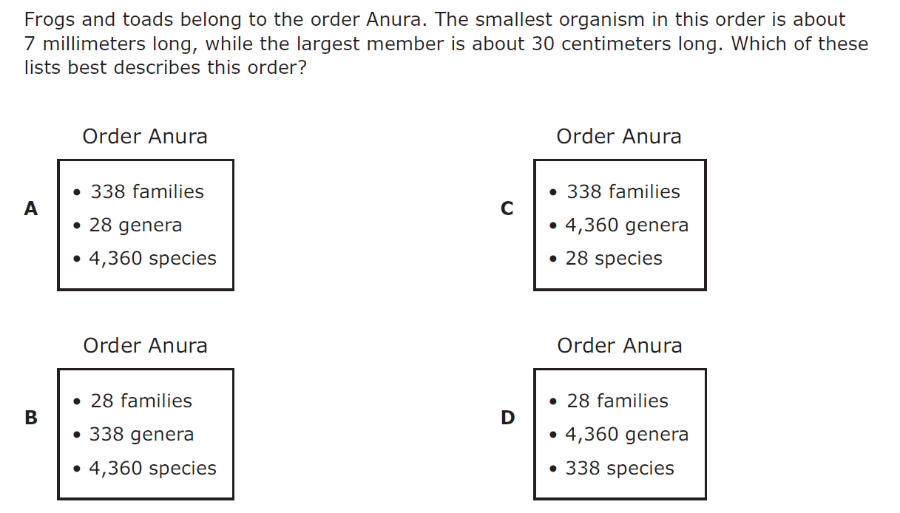
B
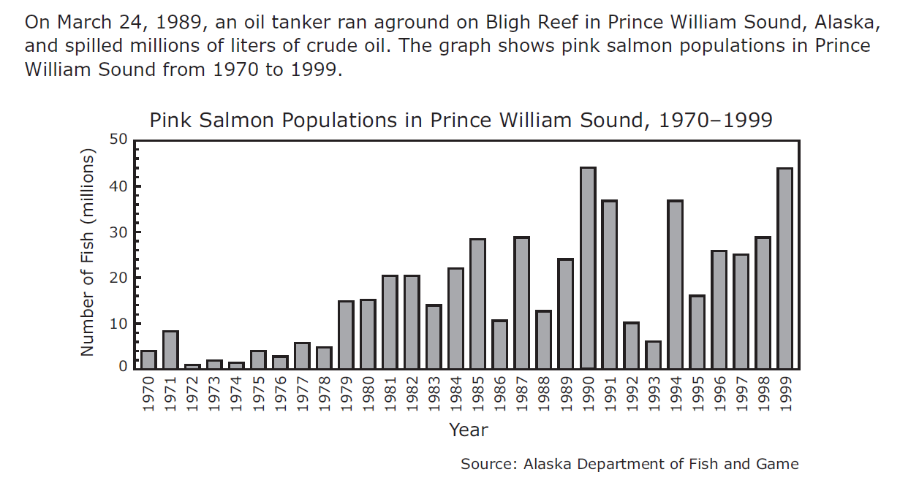
What do these data suggest about the effect the oil spill had on pink salmon?
F Pink salmon were nearly eliminated after the oil spill.
G Pink salmon populations steadily declined in the 10 years following the spill.
H Pink salmon populations declined and never fully recovered.
J Pink salmon populations seemed to be minimally affected.
J
Cells typically respond to DNA damage in three ways: by ceasing to grow and divide until the damage is repaired, by permanently ceasing to grow and divide, or by dying. In 2010 a group of scientists reported that a certain kind of immune reaction can cause DNA damage that leads to a fourth response. DNA damage can turn off genes involved in cell-signaling pathways. Turning off these genes can cause less-mature cells to divide too rapidly, often leading to the development of —
A tumors
B allergies
C hemophilia
D cardiovascular disease
A
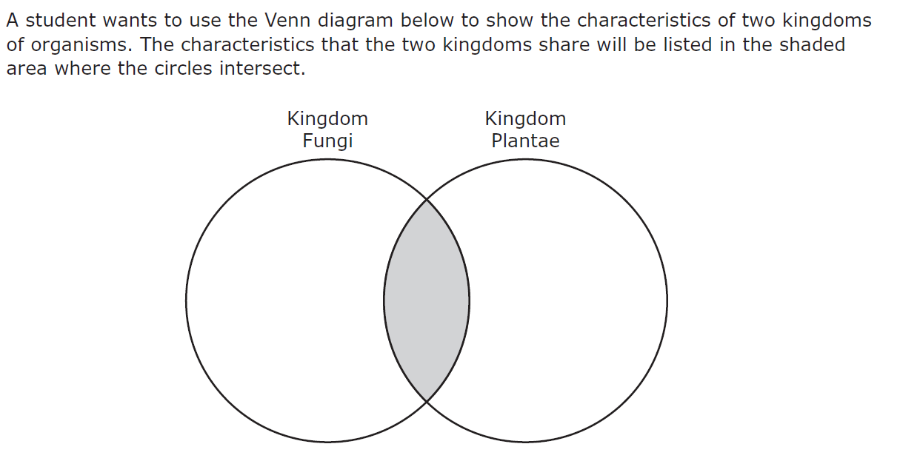
Which of these is a characteristic that the student should list in the shaded part of the diagram?
A Heterotrophic
B Mobile
C Prokaryotic
D Multicellular
D
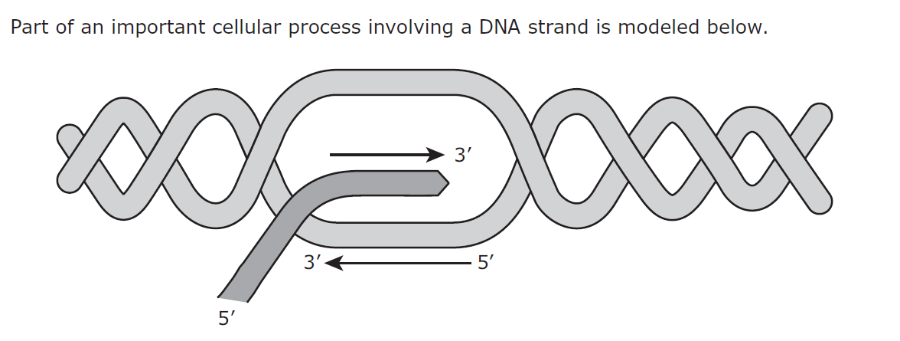
What is the purpose of this cellular process?
F Preserving genetic information for future generations
G Deleting the information in the sequence produced from the DNA template
H Transcribing information in the DNA sequence for use by the cell
J Producing more nucleotides for the DNA sequence
H
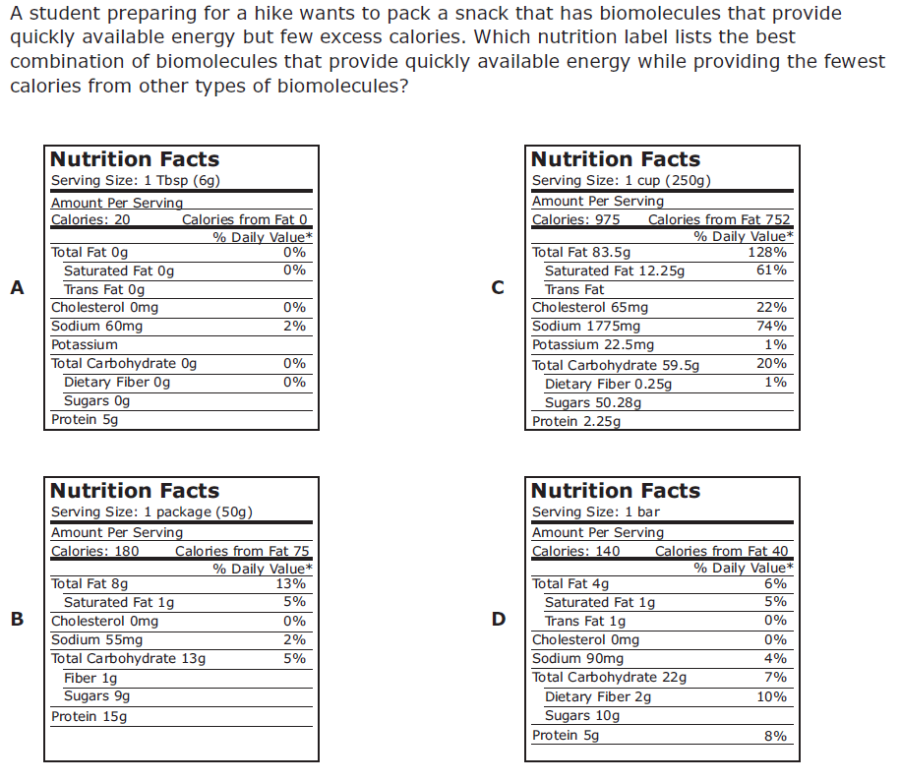
D
Organisms can be classified based on homology, which is shared characteristics inherited from a common ancestor. In the past, homologies were based on studies of anatomical structures and patterns of embryonic development. In more recent years, the use of molecular biology techniques has allowed homologies to be compared at the level of nucleotide sequences. Nucleotide sequence comparisons are possible because all organisms share which of the following?
F DNA bases
G Cellular organelles
H Division of the nuclear chromosomes
J Types of proteins needed for cellular functions
F

Which statement identifies the body systems that are directly involved in the interaction described and explains how they accomplish the interaction?
A The nervous system produces hormones that stimulate the ovum, and the circulatory system moves the ovum into the uterine tube.
B The circulatory system supplies the uterine wall with oxygenated blood, and the immune system prevents damage to the ovum.
C The reproductive system produces the ovum, and the muscular system causes the migration of the ovum by peristaltic contractions.
D The excretory system expels the ovum from the ovary, and the nervous system causes the contractions of the smooth tissues of the uterine wall.
C
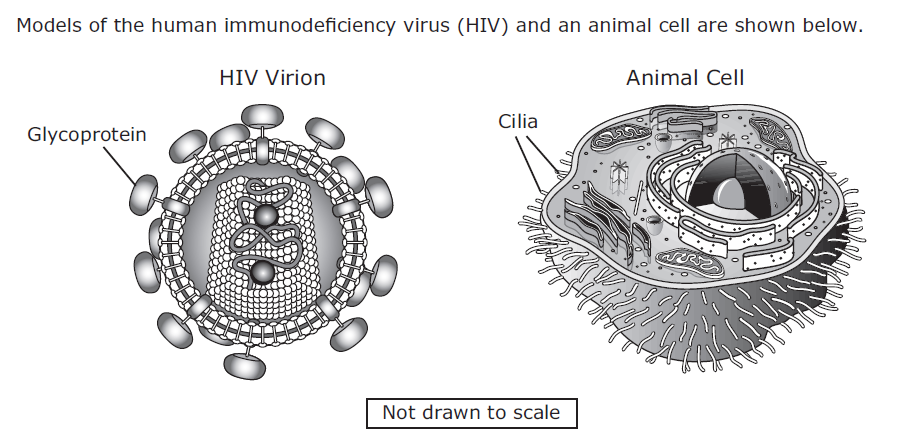
What is the difference in the function of the glycoprotein structures of an HIV virion and the cilia of an animal cell?
F The glycoprotein structures are used for attachment, and the cilia are used to move fluids surrounding the cell.
G The glycoprotein structures are used to obtain nutrition, and the cilia are used to secrete proteins.
H The glycoprotein structures are used to provide physical support for the viral envelope, and the cilia strengthen the cell membrane.
J The glycoprotein structures are used for defense, and the cilia are used for locomotion.
F
Diatoms are one of the most common types of phytoplankton in marine habitats. Like plants, diatoms contain chlorophyll and produce glucose from which of the following?
A O2 and ATP
B CO2 and O2
C ATP and H2O
D CO2 and H2O
D
A genome-wide association study involves searching the genomes of many people in order to find genetic variations associated with common diseases such as cancer, asthma, and diabetes. These studies are possible because of computer databases that allow researchers to compare the genomes of people who do not have a particular condition with the genomes of people who have the condition. In order to do this type of testing, researchers need blood samples or cheek swabs from people. Obtaining these samples is necessary because blood and cheek cells contain —
F plasma and platelets
G a complete set of DNA
H essential proteins and amino acids
J a large number of neutrophils
G
When the level of carbon dioxide in the blood is too high, the excess carbon dioxide reacts with water and produces carbonic acid. The carbonic acid causes the blood pH to become more acidic. When the blood pH becomes too acidic, chemoreceptors in the brain instruct the body to react and maintain homeostasis in blood pH. Which of these responses by the body would eliminate the excess carbon dioxide and help maintain homeostasis in blood pH?
A Increasing the body temperature by shivering
B Increasing glucose levels in the blood
C Breathing more deeply and frequently
D Decreasing the heart rate
C
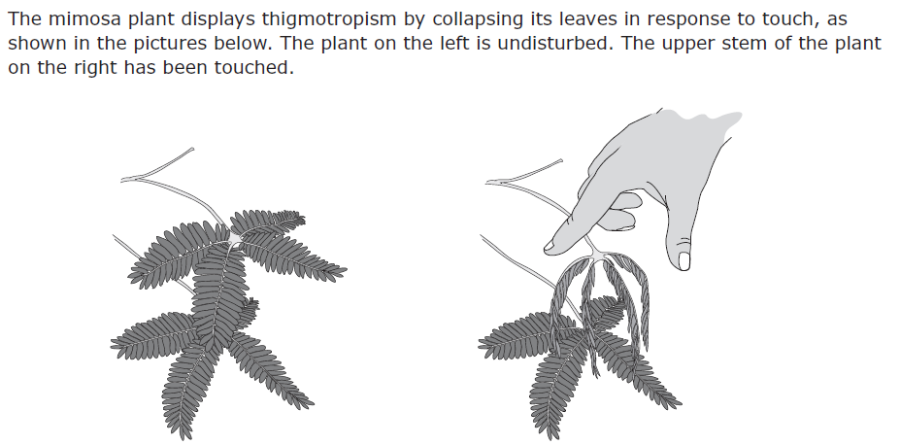
What is the most likely benefit of this mechanism for the plant?
A Protection from a loss of minerals to the environment
B Protection from poor light availability
C Protection from herbivores by becoming less attractive
D Protection from overwatering
C
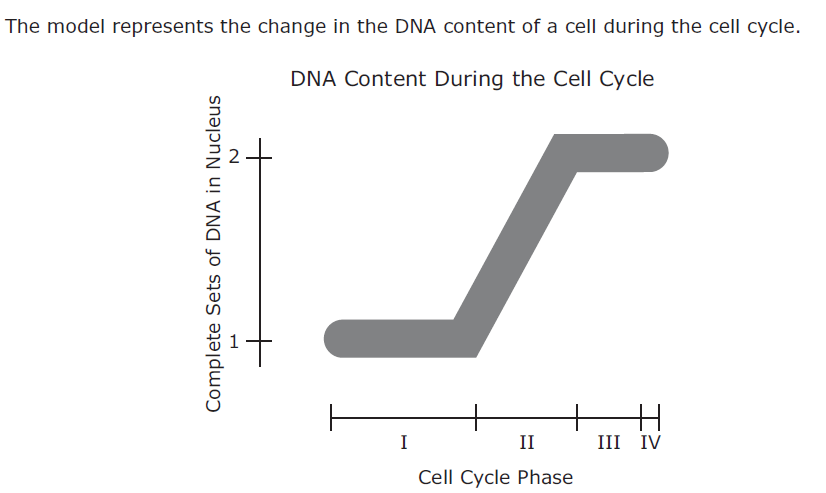
Which part of the model represents the S phase?
F I
G II
H III
J IV
G
Coracias garrulus is a blue bird with an orange-brown back. The offspring of this bird have an effective defense mechanism. The young birds vomit and cover themselves in a foul-smelling orange liquid when they sense a threat by predators. Which two systems alert the young bird to the danger and help produce the vomit it uses as a defense?
A Nervous and digestive systems
B Integumentary and muscular systems
C Immune and respiratory systems
D Excretory and reproductive systems
A
Cells can generate as many as 36 to 38 molecules of adenosine triphosphate (ATP) from the metabolism of one molecule of glucose. Which cellular process results in this amount of ATP production?
F Anaerobic cellular respiration
G Protein synthesis
H Aerobic cellular respiration
J Photosynthesis
H
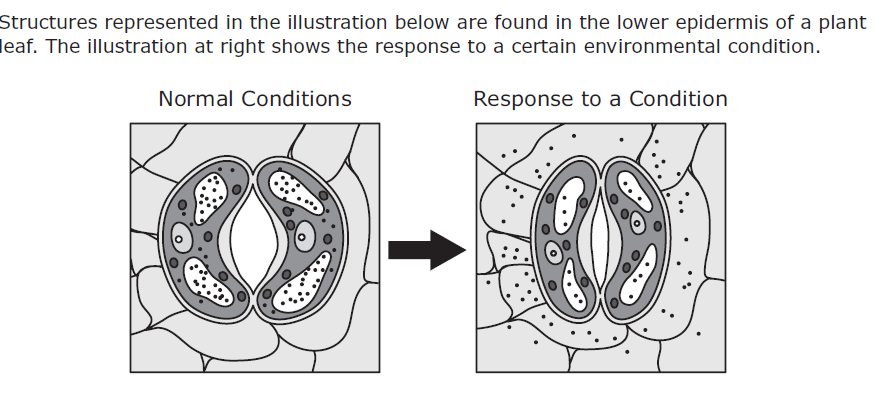
The response represented in the illustration would most likely be caused by —
A a reduced supply of oxygen
B long periods of rainfall
C high concentrations of glucose
D little available water
D
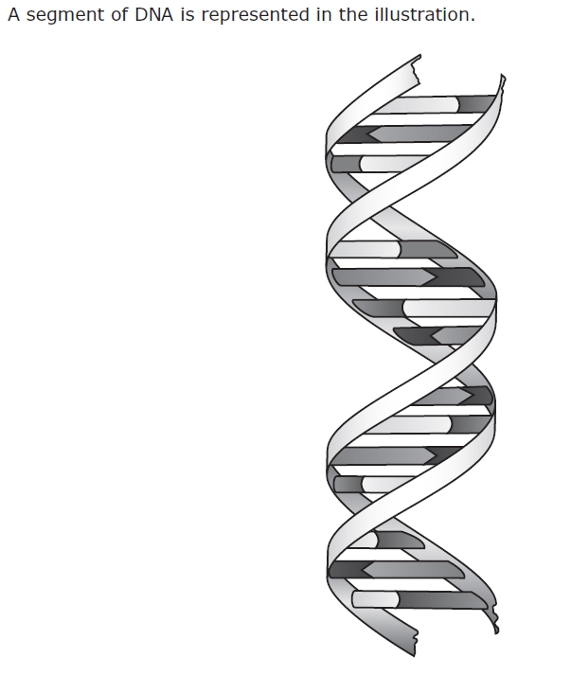
How is information for a specific protein carried on the DNA molecule?
F As a sequence of nucleotides
G In the double-helix shape of the condensed chromosome
H In the ratio of adenines to thymines
J As a pattern of phosphates and sugars
F
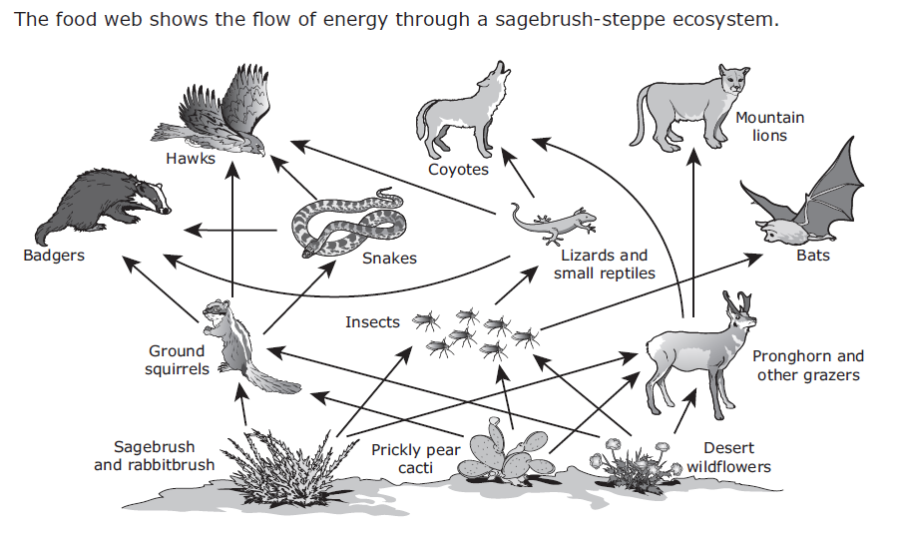
Which of these organisms are in a trophic level that receives a larger percentage of the energy captured by the producers than the percentage received at the bats’ trophic level?
A Mountain lions
B Snakes
C Hawks
D Ground squirrels
D
Fireflies emit light. The production of light by an organism is called bioluminescence. To generate visible light, cells in a firefly’s tail produce thousands of luciferase enzymes. Luciferase binds to a chemical called luciferin. Once bound, the luciferase enzyme speeds up a chemical reaction that combines an oxygen molecule and luciferin to produce oxyluciferin. This reaction requires energy and releases light. Which of the following best describes how the luciferase enzyme speeds up the chemical reaction?
F Luciferase increases the amount of time the light is visible.
G Luciferase decreases the amount of energy required for the reaction to start.
H Luciferase increases the number of sites on luciferin that must bind to oxygen.
J Luciferase decreases the temperature of the environment inside the body of the firefly.
G
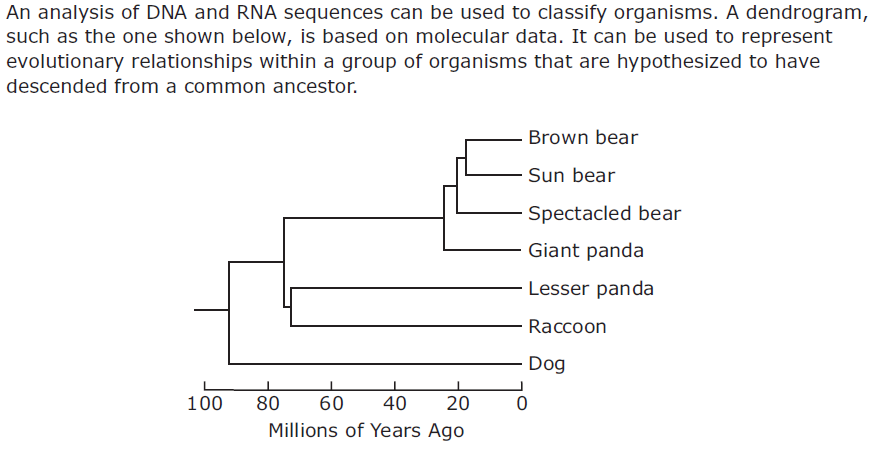
Which statement is best supported by the information in this dendrogram?
A Lesser pandas are more genetically similar to giant pandas than they are to raccoons.
B Brown bears are more genetically similar to giant pandas than they are to sun bears.
C Lesser pandas are more genetically similar to raccoons than they are to giant pandas.
D The bear species are all more genetically similar to dogs than they are to giant pandas.
C
Facial dimples and free earlobes are both considered dominant human traits. What are the expected phenotypes of the offspring of a female with dimples and free earlobes (DDFf) and a male with no dimples and attached earlobes (ddff)?
F 50% with dimples and free earlobes and 50% with dimples and attached earlobes
G 50% with dimples and free earlobes and 50% with no dimples and attached earlobes
H 75% with dimples and free earlobes and 25% with no dimples and attached earlobes
J 75% with dimples and attached earlobes and 25% with no dimples and free earlobes
F
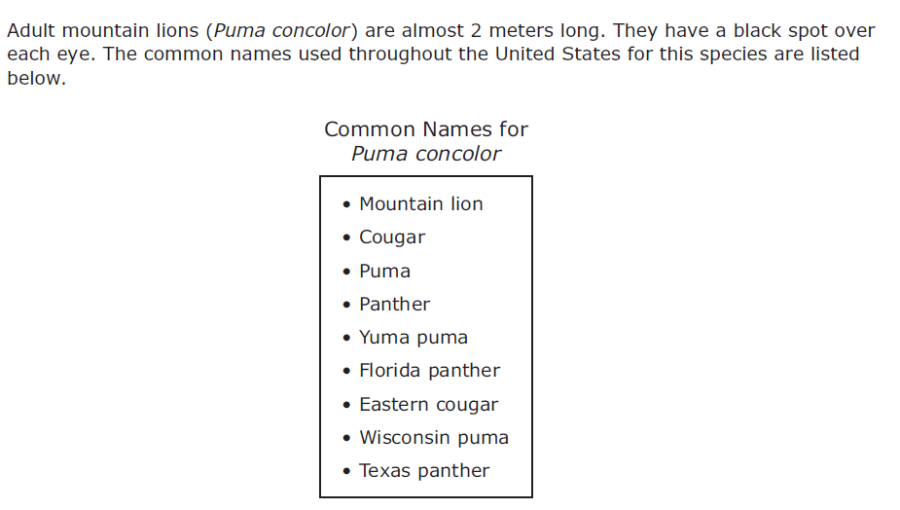
Why is it best for scientists to use the name from the standardized taxonomic system?
A The standardized name differentiates mountain lions and pumas.
B The standardized name is less descriptive of the animal that has been observed.
C Communication with other scientists about mountain lions will be reduced.
D All scientists will be using one name for mountain lions.
D
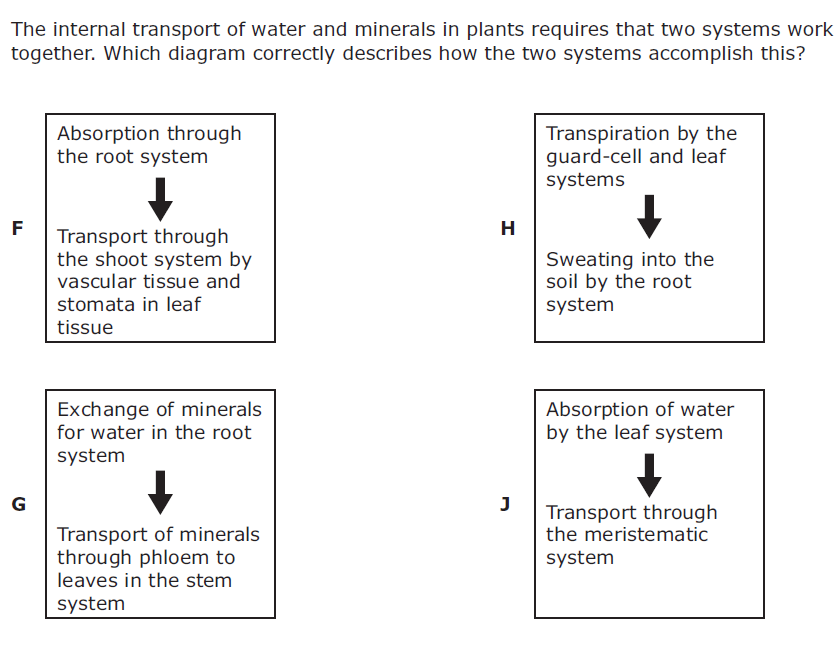
F
At birth Himalayan rabbits are usually white over their entire bodies. But when parts of their bodies reach temperatures below 35°C, a pigment that causes these parts to turn black is produced. Which of the following is most likely the cause of this phenomenon?
A Poor blood circulation
B Infection caused by cold temperatures
C Gene expression that is regulated by temperature
D A trait that is both sex-linked and hormone-dependent
C
All the animals to the right of the hagfish would have the common characteristic of —
F fur
G claws or nails
H lungs
J jaws
J
The differences between two molecules include the type of sugar that forms a section of the molecules and the identity of one of the four nitrogenous bases that make up another section of the molecules. These two molecules are —
A proteins
B lipids
C nucleic acids
D complex carbohydrates
C
How has the seed dispersal method developed by these plants given them a reproductive advantage?
F The method ensures that offspring will be dispersed and reduces competition for resources.
G The method reduces the chance that herbivores will consume the seeds.
H The method lengthens the life cycle of each of these plants.
J The method reduces the plants’ need for water and other nutrients.
F
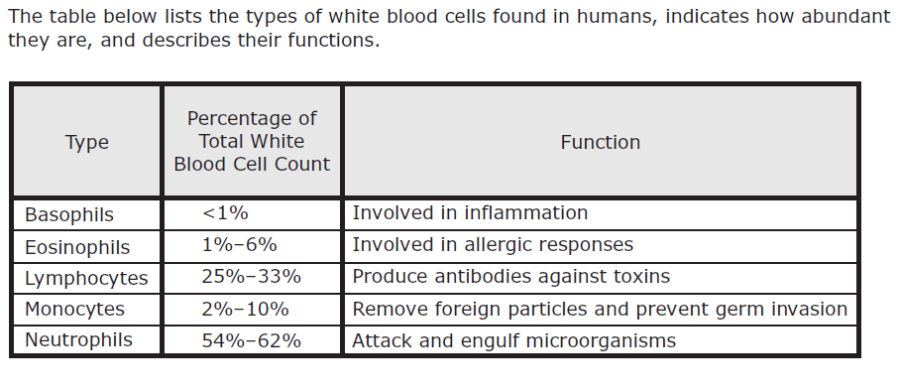
The two most abundant types of white blood cells may both be involved in a response to which of these?
A Injury
B Heat
C Allergens
D Bacterial infection
D
A science class is planning a field trip to a local farm that has a large pond. Which of the following lists the order of biological organization from smallest to largest that the students can expect to find at the pond?
F Organism, community, population, ecosystem
G Organism, population, community, ecosystem
H Population, organism, community, ecosystem
J Population, organism, ecosystem, community
G
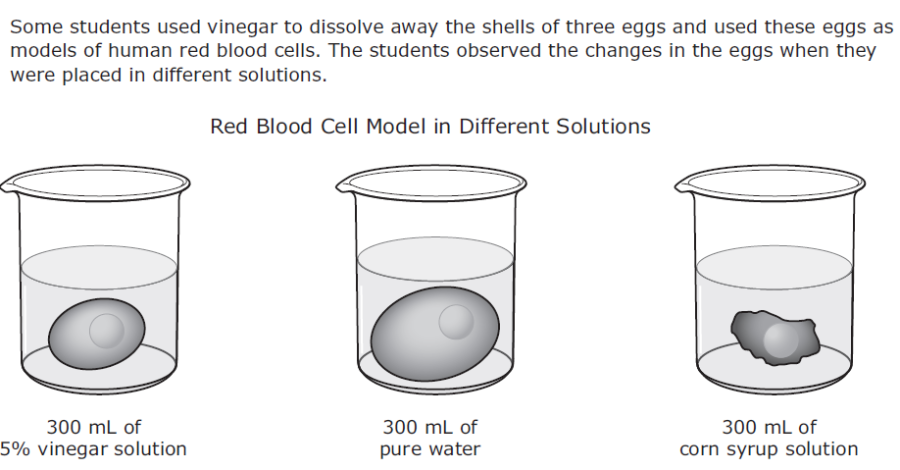
Which statement best describes the role of the cell membrane in this model?
A The cell membrane is an impermeable barrier that prevents water from entering the cell.
B The cell membrane allows solutes to enter the cell, which causes the cell to shrink.
C The cell membrane allows water to enter and leave the cell.
D The cell membrane removes solutes from the environment.
C
How can the pattern of change in the fossil record best be explained?
F The mollusks were well adapted to their stable environment. A large, sudden change occurred in their environment. After the change the mollusks with the bigger shells were better adapted for the new environment.
G The mollusks were well adapted to their stable environment. The mollusks hybridized with a smaller species of mollusk. A new species of mollusk with a bigger shell resulted.
H The mollusks were not well adapted to their environment. The length of the mollusks’ shells changed gradually over time. The mollusks in the original population that had small shells died over a period of many years.
J The mollusks were well adapted to their environment. Humans introduced a new species of mollusk that was not adapted to this environment. The introduced mollusk outcompeted the native mollusk species.
F
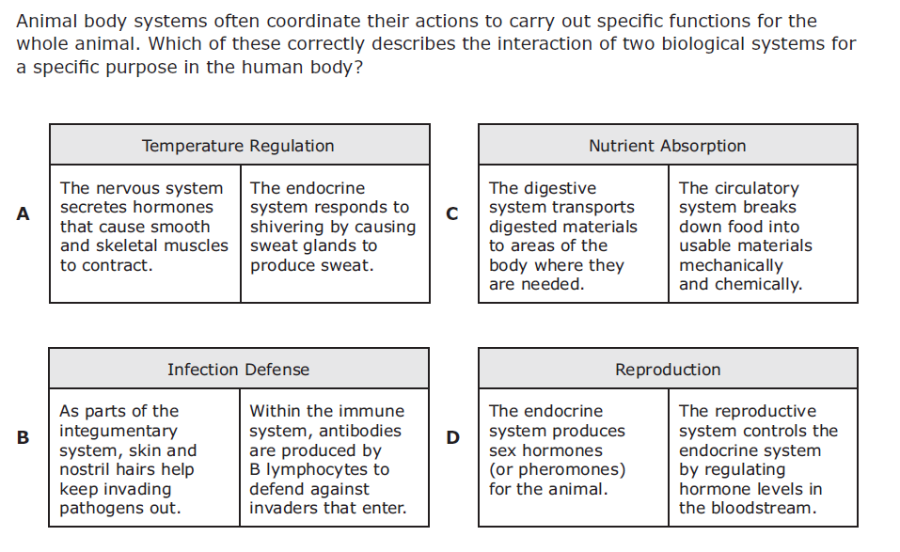
B
A student is asked to draw a food web in which the same organism is a primary consumer as well as a secondary consumer. How should the organism be represented in the food web?
F The organism must have an arrow pointing from it to a tertiary consumer and another arrow pointing from it to a decomposer.
G The organism must have an arrow pointing from it to a secondary consumer and another arrow pointing to it from the top predator.
H The organism must have an arrow pointing to it from a producer and another arrow pointing to it from a primary consumer.
J The organism must have an arrow pointing from it to a primary consumer and another arrow pointing away from it to a decomposer.
H
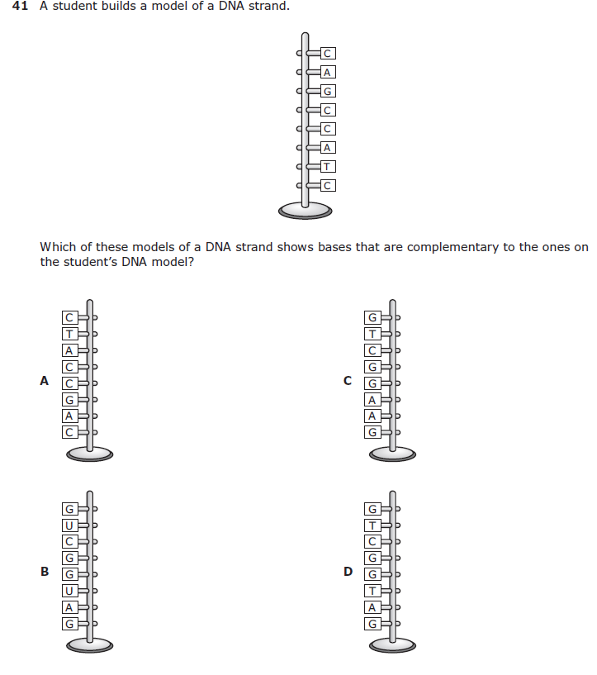
D
Bats eat insects that damage crops and mosquitoes that are vectors for disease. One million bats can eat several tons of insects per night, saving billions of dollars in pesticides yearly. Agricultural and public health scientists are concerned about the spread of white-nose syndrome (WNS). WNS is a result of a fungus that can infect cave-dwelling bats. While bats hibernate during winter months, the fungus covers the bats’ face and wings. WNS has a near 100% mortality rate, and 5.7 million bats have died since the discovery of the fungus in 2006. Many scientists are searching for ways to protect these bats. The relationship between this fungus and bats can best be defined as —
F commensal, because the bats provide a surface for the fungus to grow
G parasitic, because the fungus obtains nutrients and shelter from the bats
H competitive, because both organisms use caves as shelter during the winter
J mutualistic, because the relationship involves two distinct species living together
G
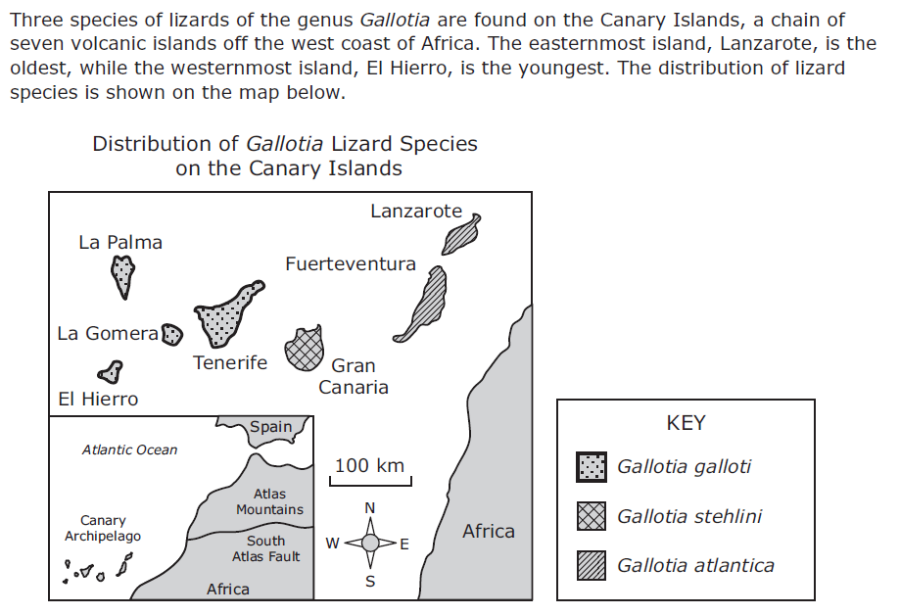
Which statement about the ancestry of the lizards from the genus Gallotia is best supported by this information?
A The common ancestor of the lizards first colonized the island of El Hierro.
B The ancestors of each species came from different continents at different times.
C The common ancestor of the lizards probably came from Africa.
D The ancestors of each species evolved in Spain and were brought to the islands at the same time.
C
Human body cells each have 46 chromosomes in their nuclei. Meiosis is necessary in order to ensure that each gamete produced in the human body has —
F 12 chromosomes
G 23 chromosomes
H 46 chromosomes
J 92 chromosomes
G
How do an increase in the organic matter in soil and an increase in soil depth affect the population of plants in an area?
A Larger plants become the dominant organisms.
B Mosses replace flowering plants.
C Nitrogen-fixing bacteria kill young trees.
D Grasses become diseased.
A
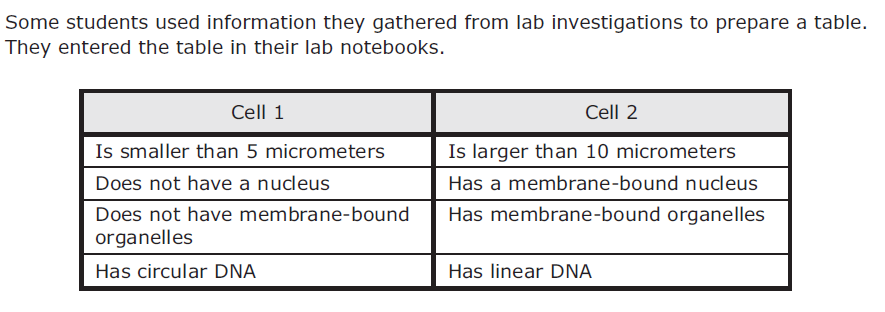
Which of these correctly identifies the two cells described in the table?
F Cell 1 is eukaryotic, and Cell 2 is prokaryotic.
G Cell 1 is prokaryotic, and Cell 2 is eukaryotic.
H Both Cell 1 and Cell 2 are eukaryotic.
J Both Cell 1 and Cell 2 are prokaryotic.
G
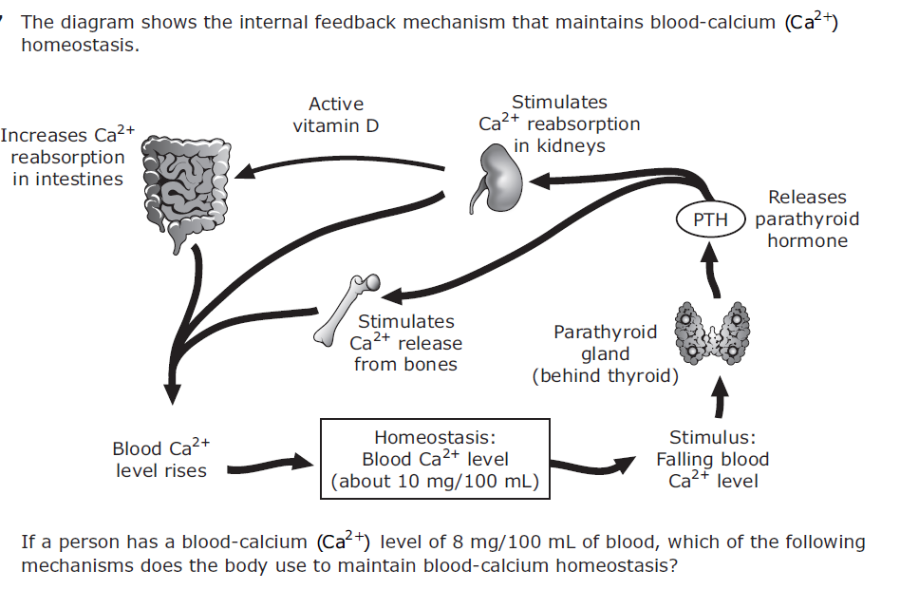
If a person has a blood-calcium (Ca2+) level of 8 mg/100 mL of blood, which of the following mechanisms does the body use to maintain blood-calcium homeostasis?
A The kidneys take up more Ca2+ and release vitamin D.
B The bones release Ca2+.
C The intestines increase reabsorption of Ca2+.
D All of the above
D
In dry desert areas poor drainage can lead to a buildup of salt in water supplies. A student performed an investigation to study the effects of salinity on the germination rates of seeds. The student placed seeds in several solutions containing 0% to 3% salt. The length of the radicle, which is the root of the germinating seed, ranged from 49 mm in the 0% salt solution to 0 mm in the 3% salt solution. The data from this investigation suggest that increased salinity in more areas may lead to a decrease in which of the following?
F Air pollution
G Food production
H Oceanic evaporation
J Nonrenewable resources
G
In the 1960s the molecular biologist George Streisinger developed the strand-slippage hypothesis. Streisinger noticed that mutations occurred in areas of DNA that contained many repeated sequences. When a strand-slippage error occurs, an insertion mutation can result. How does the insertion mutation affect the DNA?
A Nitrogenous bases are added.
B Nitrogenous bases are exchanged.
C Nitrogenous bases are damaged.
D Nitrogenous bases are deleted.
A
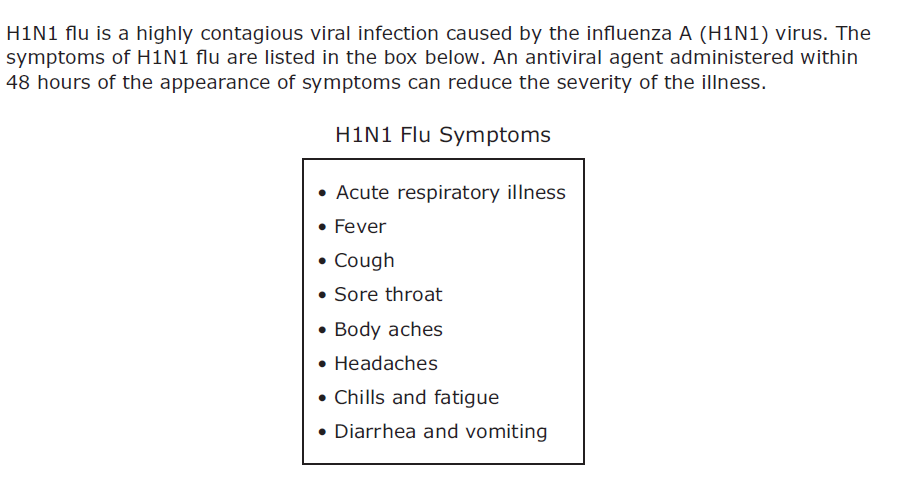
Why is it important to administer an antiviral agent to an infected person within 48 hours of the appearance of symptoms?
F The H1N1 virus is dormant in cells.
G The H1N1 virus replicates quickly.
H The H1N1 virus does not mutate.
J The H1N1 virus is transmitted through a vector host, such as a mosquito.
G
Normal fruit flies have brownish-yellow bodies, and this body color is dominant. A mutation in the gene for body color can produce flies with an ebony body color. A homozygous normal fruit fly (e+e+) is crossed with a homozygous ebony fruit fly (ee). What is the predicted outcome of this genetic cross?
A All the offspring will have ebony bodies.
B Of the offspring, 75% will have brownish-yellow bodies, and 25% will have ebony bodies.
C All the offspring will have brownish-yellow bodies.
D Of the offspring, 75% will have ebony bodies, and 25% will have brownish-yellow bodies.
C
Scientists can bioengineer skin in a laboratory to treat severe burns and other types of skin injuries. This bioengineered tissue is grown from living cells. The cellular process that enables the cells to grow and develop into tissue is —
F conjugation
G meiosis
H budding
J mitosis
J
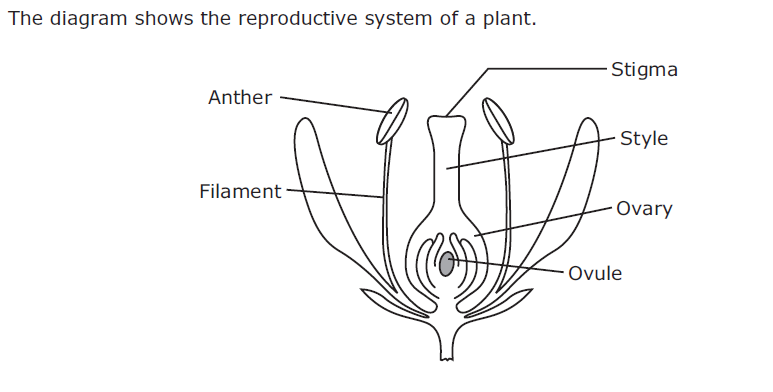
Which of the following best describes the interaction that occurs between a plant’s reproductive parts during self-fertilization?
A Pollen is released from the anther and is transferred to the stigma. A pollen tube forms and grows through the style. The pollen tube reaches the filament, where the sperm fertilizes the egg.
B Pollen moves from the ovule up through the style and is released from the stigma. The pollen is transferred to the anther, where the sperm fertilizes the egg.
C Pollen is released from the anther and is transferred to the stigma. A pollen tube forms and grows through the style. The pollen tube reaches an ovule within the ovary, where the sperm fertilizes the egg.
D Pollen is released from the stigma and is transferred to the anther. A pollen tube grows down from the anther through the filament and fuses with the ovule, where the sperm fertilizes the egg.
C
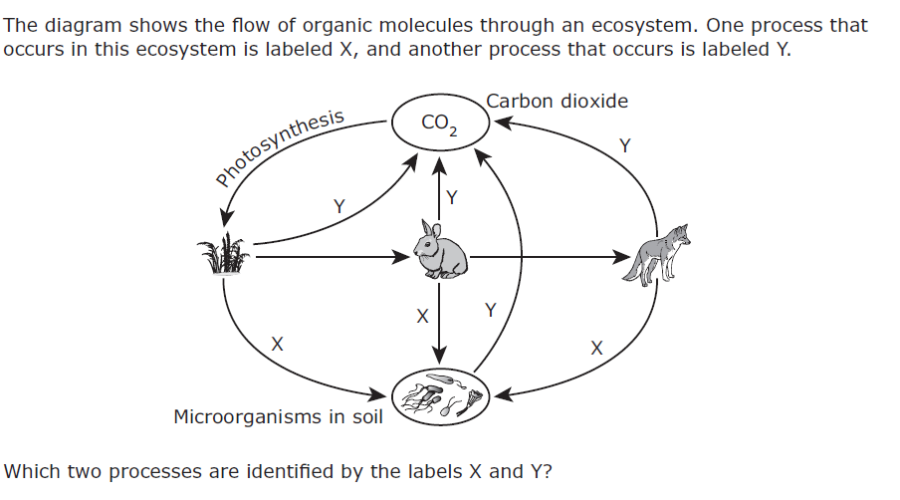
Which two processes are identified by the labels X and Y?
F X: RespirationY: Predation
G X: AdaptationY: Decomposition
H X: FermentationY: Nitrogen fixation
J X: DecompositionY: Respiration
J